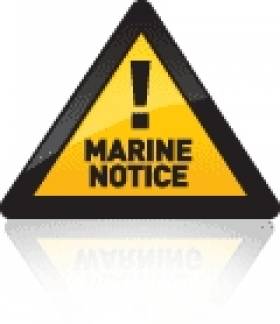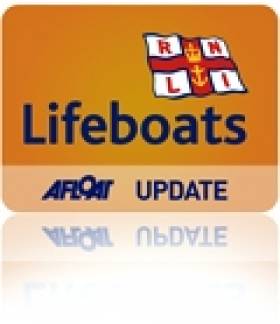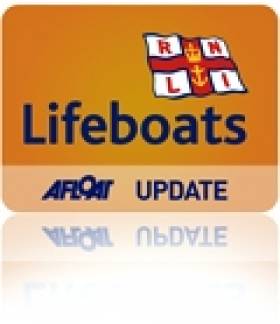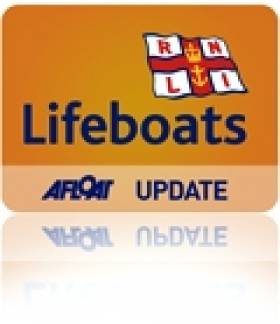Displaying items by tag: Howth
Irish Sailing Review 2014: A Year Of Hope, Regeneration & Success
#irishsailingreview – 2014 has been the year in which Irish sailing regained its international confidence afloat by re-capturing the Commodore's Cup. Having won it in 2010, the national economic collapse prevented any defence in 2012, but in July 2014 the stain and shame of 2012's non-appearance was emphatically wiped from memory with a convincing team victory led by Anthony O'Leary.
Ashore meanwhile, it had taken longer in some quarters for the economic realities to become fully evident and accepted. But for the Irish Sailing Association, a grassroots revolution within the national authority and sailing in general in 2014 resulted in a root-and-branch analysis of the workings of the Association, which had been heading towards financial disaster through a combination of over-staffing, grandiose schemes of expansion and empire-building, and an emphasis on activities and programmes which were remote from the needs of ordinary sailors throughout Ireland.
It took six months to turn round the course of the Association. But on November 5th 2014 the new ISA President, David Lovegrove, was able to announce a far-reaching re-structuring which is already resulting in a leaner and fitter body, better able to provide a realistic service for clubs and the huge diversity of recreational activity on Ireland's seas and lakes.
While all this high profile activity and action has been taking place at international and national level, those Irish sailors who had managed to keep up their sport through the financial downturn – albeit in often very reduced circumstances – continued to sail their boats with the attitude that, while the economic situation was disastrous, it mustn't be allowed to become serious, and in some ways the best course out of the recession was to sail through it. W M Nixon casts an eye over the year's main activities.
In the Irish sailing year, Christmas Day is New Year's Eve. Next morning, on December 26th – St Stephen's Day or Boxing Day or whatever you're having yourself – the annual 628-mile Sydney-Hobart Race starts. It may be on the other side of the world, and it may still be in the very last days of the old year. But Irish interest at home and in Irish-Australia is always high, and in the sailing community it's seen as the start of the new season.
December 26th 2013 was in line with this, as we'd ex-Pat superstar Gordon Maguire – a previous Hobart race overall winner – very much in contention with Matt Allen's totally new Carkeek 60 Ichi Ban, we also had Sean McCarter of Lough Swilly YC skippering Derry/Londonderry in the warmly-welcomed Clipper Fleet of 70-footers designed by Tony Castro (formerly of Crosshaven) which were taking in the Hobart race as part of their global circumnavigating race, and we'd Barry Hurley and Kenny Rumball on the First 40 Breakthrough knowing that in the 2010 Hobart race, the new design's race debut, First 40s had taken first and second overall.
In a rugged race in which the wind got up to gale force and more towards the end, it was a much-loved hundred footer, Bob Oatley's continually-modified Wild Oats XI, which stole all the headlines with line honours, a course record, and a class win. Irish hopes were best met by Sean McCarter, who logged a very clear win in the Clippers. As for Ichi Ban, while she was third in IRC Div 1 and 8th overall, it wasn't quite a stellar performance, reinforcing the views of those of us who think the boat may be just a little too plump by today's lean and hungry standards. And aboard Breakthrough, they'd 8th in class and 29th overall, a useful performance perhaps, but Barry Hurley will be back on December 26th 2014, boosted by his first in class and second overall in October's Middle Sea Race.
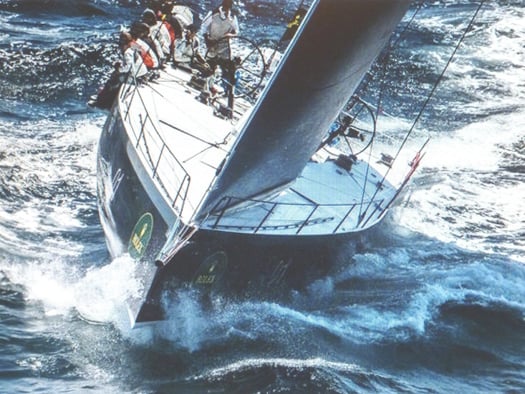
Matt Allen's Ichi Ban in the Rolex Sydney-Hobart Race of 2013, with Gordon Maguire as sailing master. To some observers, the very new Carkeek 60 seemed distinctly plump in her hull form forward compared to her closest competitors
In late January 2014, attention focused on the Quantum Key West Regatta in the Florida Keys, where Irish Olympic sailor Peter O'Leary of Cork was on the strength of New York art dealer Marc Glimcher's completely new and very potent looking Ker 40 Catapult. The boat did the business afloat in Florida, but further business was done ashore, as Anthony O'Leary himself was in Key West to see if he could sign up Catapult to be the secret ingredient in Ireland's Commodore's Cup team, for which at that stage the only certainty was his own older Ker 39 Antix. There seemed to be agreement, but in the volatile world of international trading and snap decisions in which top modern sailing operates, there can be sudden reversals of fortune, and O'Leary later admitted that until Catapult was actually unloaded from a ship in Europe, he hadn't been a hundred per cent certain she'd show.
Key West had further Irish interest in that veteran skipper Piet Vroon's Ker 46 Tonnere de Breskens – a former Round Ireland Race winner – was another star in the show, but much was to happen in Irish sailing before the Round Ireland 2014 got under way in Wicklow on June 28th.
With March slowly showing signs of Spring, university racing came centre stage, and it was University College Dublin which came through on top to qualify as Ireland's representatives in the Student Yachting Worlds in France in October, the team led by Philip Doran.
Another team was emerging as the Irish Cruiser Racing Association (ICRA) announced that our Commodore's Cup squad would be Anthony O'Leary's Ker 39 Antix, Marc Glimcher's Catapult, and the Grand Soleil 43 Quokka chartered by Michael Boyd and Niall Dowling, with Anthony O'Leary as team captain. He in turn would be supported by the shore management team, for a very intense week of racing, of Barry Rose and Fintan Cairns, with Mike Broughton in what would prove to be the particularly onerous task of Team Meteorologist.
As 2014 was exactly midway between two Olympiads, top level international dinghy sailing to Olympic standards might have been expected to be on the back burner. But Ireland's Olympians were very much on track on the international scene, and busy with their own programmes which culminated in the ISAF Worlds in Santander where Olympic places in Rio de Janeiro for 2016 were secured by James Espey in the Laser, Ryan Seaton & Matt McGovern in the 49er, and Annalise Murphy in the Women's Laser Radial. All were of course also seen in other boat types from time to time, with Annalise in particular bringing some glamour to the growing class of foiling Moths in Ireland.
Annalise on the foiling Moth
Other top international women sailors had descended on Ireland in early June with the ISAF Women's Match Race Worlds at Crosshaven. It's very much a specialist sailing interest, but aspiring Irish woman sailors attracted to this discipline found that this successful regatta provided some very useful networking contacts and future crewing possibilities, while the racing itself saw Sweden's Anna Kjellberg of the Royal Gothenburg YC become the new champion after defeating Camilla Ulrikkeholm of Denmark in the final.
In an entirely different area of sailing and life afloat, the traditional boat scene had come early to life with the Baltimore Wooden Boat Festival at the end of May. In the Irish climate after a particularly damp Spring, it reflected great credit on those involved that there was such a good turnout, ranging from the Shannon Gandelows from Limerick recently returned from their historic visit to Venice, through the many restored classic yachts of the region, also including the lovely Shannon cutter Sally O'Keeffe from Kilrush, and going on into the restored traditional mackerel and lobster yawls which make West Cork their home.

Shortly after their historic visit to Venice, the Shannon gandelows built by the Ilen School took part in the Baltimore Wooden Boat Festival at the end of May. The gandelow here, rowed by Liam O'Donghue, Anthony Kenny and Robert Samlle, is headed across Baltimore Harbour towards the gaff ketch Sile a Do.
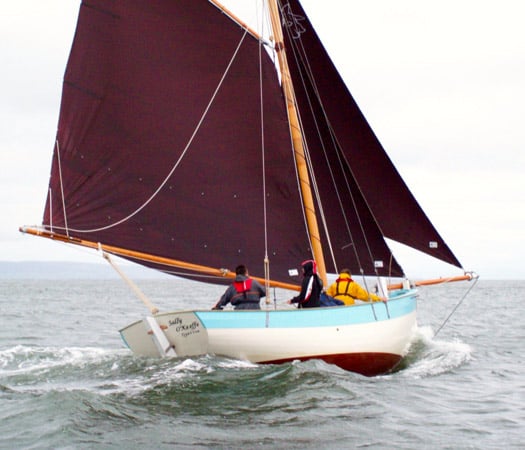
The pride of the Shannon Estuary - Sally O'Keeffe was built in a community effort in Querrin on the Loop Head peninsula.

The traditional lobster boat Saoirse Muireann (left, Cormac Levis) and the mackerel yawl An tiscaire (Uilliam O'Lorcain) are a familiar sight in the waters of West Cork. Photo: Brian Marten
They were to re-appear in even greater numbers at the Ballydehob Gathering of the Boats in early August, a month during which the classic Galway Hookers of the West Coast were at their busiest on their home Atlantic waters, but the East Coast also had its moments with the Riverfest in Dublin's Liffey in early June seeing traditional and classic craft in a lively mix.

Sails in the City – two of the 1898 Howth Seventeens racing in the heart of Dublin in the Liffey Riverfest. Photo: W M Nixon
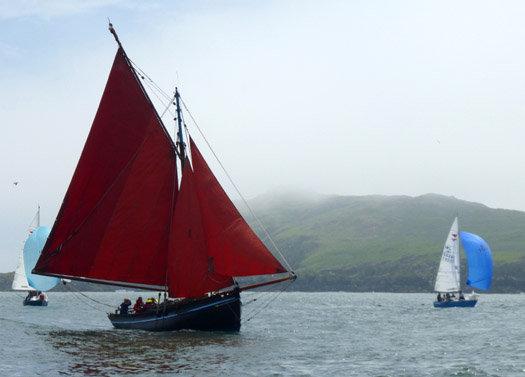
It could almost be Connemara, were it not for the Puppeteer 22s – the Galway Hooker Naomh Cronan in the new Classics & Traditional Division in Howth's annual Lambay Race, which was marking its 110th anniversary in 2014. Photo: W M Nixon
Indeed, so strong is the growing interest in classics and trads on the East Coast that to celebrate the centenary of the Lynch family's Howth 17 Echo (one of the newest of the class, the most senior ones were built in 1898) Howth YC provided a traditional Lambay Race course – simply up around Lambay and back to Howth Harbour – for the Seventeens and a new Classics Division, with the Howth 17s seeing the first two places taken by 1898 boats – Rita (John Curley & Marcus Lynch) and Aura (Ian Malcolm) – while Old Gaffers Association International president Sean Walsh won the classics with his Heard 28 Tir na nOg from the Clondalkin team's Galway Hooker Naomh Cronan. As for the overall prize among the large fleet of more modern boats sailing their more complex course, that was won by Colm Bermingham's Bite the Bullet.
The countdown to the Commodore's Cup had continued with inspirational performances by Anthony O'Leary in the Easter Challenge in the Solent, where he won his class with Antix, and then in June he did the same again with the British IRC Championship. Back home, ICRA held their Nationals with the Royal Irish YC in Dun Laoghaire in mid-June, and out of a fleet of a hundred plus boats it was the vintage Marcus Hutchinson/Rob Humphreys designed Quarter Tonner Quest (Jonathan Skerritt, RIYC) which was best overall scorer, a notably impressive performance also being put in by the Ker 36 Jump Juice (Denise Phelan) from Crosshaven.

The 27-year-old Quarter Tonner Quest (Jonathan Skerritt) was overall winner in the ICRA Nats at the RIYC in Dun Laoghaire. Photo: David O'Brien

Downhill battle at the ICRA Nats with the Mills 36 Raptor (ex-Aztec) in foreground, while beyond is Peter Dunlop of Pwllheli's J/109 Mojito against the XP33 Bon Exemple (Colin Byrne, RIYC). Photo: Davd O'Brien

The Ker 36 Jump Juice (Denise Phelan) dominated Class 0 at the ICRA Nats. Photo: David O'Brien
The end of June, and it was Round Ireland time. Thirty-six boats started from Wicklow, 33 finished in a race which was mostly on the slow side, with mid-size boats having their day. The winner was Richard Harris's Sydney 36 Tanit from Scotland by just six minutes from the home favourite, Liam Shanahan's J/109 Ruth from the NYC in Dun Laoghaire. The French defending champion, Laurent Gouy's Ker 39 Inis Mor which sails in Ireland under the burgee of Clifden Boat Club, placed third while Frank Doyle of Cork, second generation round Ireland aristocracy as son of Denis of Moonduster fame, was fourth with his A35 Endgame.
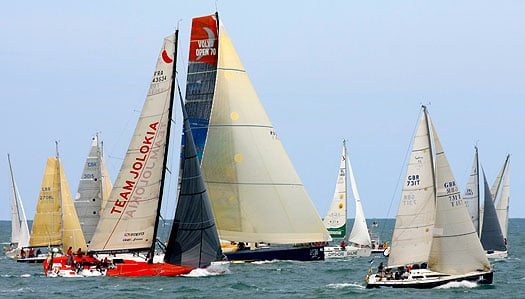
The start of the Round Ireland Race 2014 well illustrates the eclectic nature of the fleet. In right foreground is Richard Harris's Sydney 36 Tanit which was overall winner by just six minutes from the J/109 Ruth (Liam Shanahan), just beyond with the black jib, while the Volvo 70 Monster Project (David Ryan) comes thundering through the fleet at the beginning of a performance whch would see her take line honours win and thd class win in the CK Div.. Photo: Kevin Tracey
The same weekend as the Round Ireland race started, Lough Foyle sent the Clipper Fleet on their way after a week's festivities in Derry/Londonderry, made even more festive by the fact that Sean McCarter and his crew with the home town's boat had crowned their win in the Sydney-Hobart race with victory in the Transatlantic leg to Derry.
Clipper fleet in Derry
Crosshaven fairly leaped to life with Cork Week in July, and after several hitches in various boat-shipping plans, it was notable as the first time the Irish Commodore's Cup Team 2014 were seen together, and mighty impressive they looked too, with Quokka proving best on the Cork Week leaderboard.
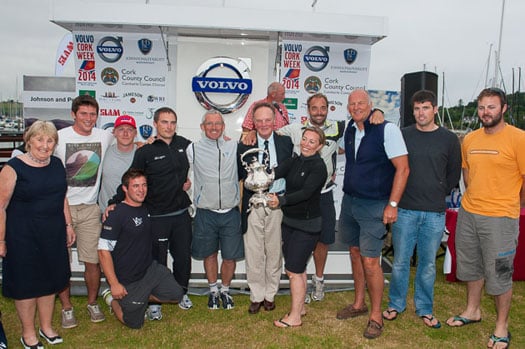
Michael Boyd (centre behind cup) and his Quokka crew, a member of Ireland's Commodore's Cup team, were overall winners of Cork week 2014. Photo: Bob Bateman
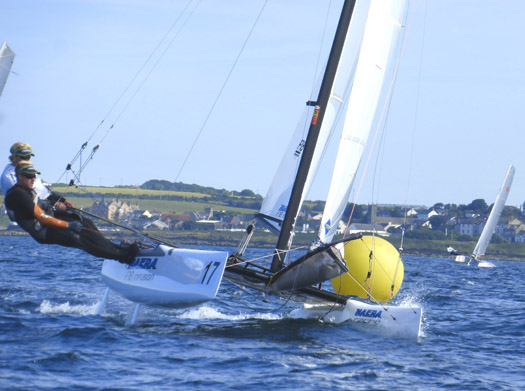
In the F18 Worlds at Ballyholme, Dutch skipper Gunnar Larssen (crewed by Ferdinand van West) is seen here putting in the smooth performance which saw him winning the worlds at his thirteenth attempt. Photo: W M Nixon
While all this excitement in racing boats with lids was building on the south coast in July, up north on Belfast Lough at Ballyholme the F18 Worlds were held for one of global sailing's most popular catamaran classes. Though the entry of 56 boats didn't match the 150-plus entries they get when the class has its worlds in its Mediterranean heartlands, the sailing was good and a popular winner emerged in longtime F18 sailor Gunnar Larsen, who is Dutch despite his Scandinavian name.
Dinghy attention was also very closely focused on Dublin Bay, with an enormous fleet of Optimists at the Europeans hosted by Royal St George YC from 12th to 20th July, and Dun Laoghaire really showing what it can do in being a major international regatta centre. France's Enzo Balanger was tops from Sweden's Kasper Nordenram, while best of the Irish in the Gold Division was Royal Cork's James McCann in tenth – not surprisingly, he was to go on to win the Nationals at his home club in August.

Nations from across Europe and beyond were at the Optimist Euros at Dun Laoghaire

Finn Lynch racing at Douarnenez in France where be became the new U19 Laser Standard world championPhoto: Trevor Millar/Sail Coach
On the broader international scene, former Opty stars Finn Lynch (National YC) and Seafra Guifoyle (Royal Cork) were to turn in outstanding results during 2014, with Guilfoyle firmly in the frame through the ISAF Youth Worlds in the Laser, eventually coming home from Tavira in Portugal with the Silver, while Finn Lynch was on top form to clinch the Gold in the Under 19 Laser Standard Worlds at Douarnenez in Brittany.
Back aboard the boats with lids, late July had brought the Commodore's Cup in the Solent, and if anyone out there doesn't know who won, we'd like to hear from them, as the state of total seclusion which this implies is surely something which could be packaged and marketed to our hyper-informed and over-crowded world. The comprehensive Irish victory just seems better and better with the passage of time, and for Anthony O'Leary it was the highlight of a fantastic season which in September was to see him win the Helmsman's Championship of Ireland (admittedly by just a whisker) in J/80s in Howth to set up a national double for Royal Cork, as young Harry Durcan of Crosshaven was winner of the Junior Helmsmans. O'Leary meanwhile went on to win the 1720 Nationals in Baltimore later that month, and then in November his beloved Antix was named RORC Yacht of the Year.

Antix in the Commodore's Cup, hanging in well coming to the weather mark to stay ahead of the newer Ker 40 Cutting Edge. Photo: Rick Tomlinson)
Even as Antix and her team mates were racing on towards glory in the Solent, in Clew Bay the West of Ireland Offshore Racing Association (WIORA) were staging their annual championship at hospitable Mayo SC, and it saw a good spread of results, with the overall winner being Galway's Liam Burke with his Corby 25 Tribal, while the runner-up was the McGibneys' Dehler Optimum 101 Dis-a-Ray, which sails under the Foynes YC burgee, but her home port is Tarbert further west along the Shannon Estuary.
August was busy with events for enjoyment. Eighty boats raced in Calves Week in West Cork, which has now been compressed to a four day regatta which means, as one sage family man observed, that you can take a house in Schull for a week's holiday, and then just as the wife and kids are getting fed up with having the ould fella always about the place, doesn't he absolutely have to go off and spend the last four days of the holiday sailing with his mates? That one of the top boats was Colman Garvey's True Penance maybe says it all.

Calves Week 2014 entries were up 25% in 2014. Photo: Bob Bateman

The GP14 Worlds at East Down YC in Strangford Lough launched a hundred boats every day in smooth style. Photo: W M Nixon
The biggest dinghy event of all (other than the Laser Nationals, which as ever are in a league of their own) was the GP 14 Worlds in mid-August at East Down YC in Strangford Lough, which had its excitement in a sudden storm on the Monday, but it all turned out okay. Boats involved were just over the hundred mark, the best boats were built in Northern Ireland by Alistair Duffin, and winners were English crew of Ian Dobson and Andy Tunnicliffe from Burwain, while top Irish were John and Donal McGuinness of Moville in Donegal, they were sixth.
At the other end of the intensity scale, down in Howth they had their first cruiser-racer two-hander for the Aqua Restaurant Challenge. Despite very restrained pre-publicity, it attracted 34 boats for a race round Lambay and the Kish. Stephen O'Flaherty's elegant Spirit 54 Soufriere, fresh from a win in the Panerai Classics in Cowes and co-sailed by David Cagney, took line honours and almost won, but the vintage Humphreys Half Tonner Harmony (Peter Freyne and Jonny Swann) just pipped them at the end.
Sailed in summery weather, the new Howth two-handed was about as different as possible from another two-handed experience in August, that of Liam Coyne (NYC) and Brin Flahive (Wicklow) in the 1800 mile RORC Seven Star Round Britain and Ireland. They didn't have to be two-handed, there were fully crew boats involved including the 70ft–trimaran Musandam in which Ireland's Damian Foxall played a leading role in taking line honours in record time, but aboard the First 36.7 Lula Belle the Irish duo just toughed it out despite sailing the last 500 miles with virtually nothing functional, they simply decided to see it through, and to their amazement found they'd won Classes V & VI.
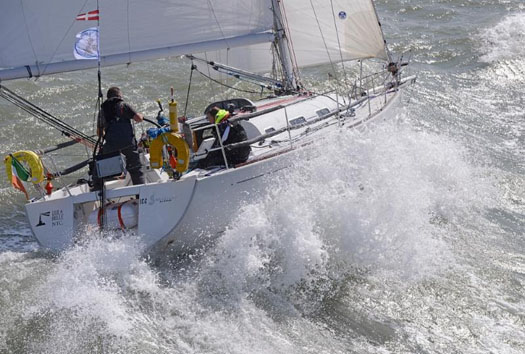
Lula Belle on her way out of the Solent with 1800 miles to race. Photo: Rick Tomlinson
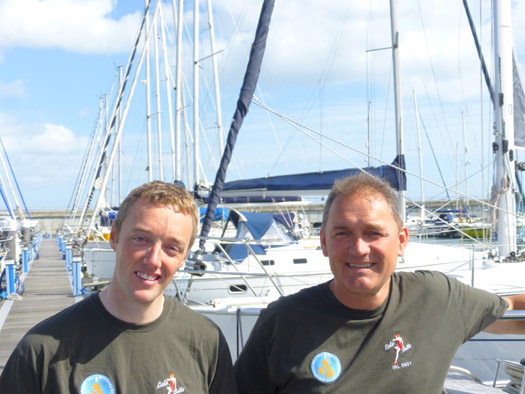
Brian Flahive & Liam Coyne back in Dun Laoghaire on the morning of their return from the finish of the Round Britain & Ireland Race. Photo: W M Nixon
As for the Laser Nats, they were at the end of August and another Ballyholme event, with Johnny Durcan of Royal Cork winning from Rory Fekkes of the home club, while the radials saw Annalise Murphy keep her hand in with a win from Cork's Cian Byrne.
After some rugged August weather, particularly on Ireland's East Coast, September was utterly blissful and it sweetly rounded out Dublin Bay Sailing Club's 130th season, the birthday being marked by a fairly epic dinner in the National YC. September also saw the conclusion of the slowly but steadily reviving Irish Sea Offshore Racing programme, with the end-of-season race from Pwllheli to Dun Laoghaire seeing Liam Shanahan's J/109 Ruth confirmed as the overall winner of the series. Among locally campaigned dinghies, meanwhile, Dun Laoghaire's keen Fireball Class kept its annual programme in lively shape, and the season drew a close with Barry McCartin and Conor Kinsella winning overall from Noel Butler and Stephen Oram.

ISORA Champion Ruth skippered by Liam Shanahan jnr from the National Yacht Club
Across country in Limerick, the CityOne dinghies and the traditional Shannon gandelows created in projects of the Ilen Boatbuilding School made their debut in the city centre on one of the last days of the Indian summer, and then they were put on display in a Naumachia in St Mary's Cathedral which was officially opened by Michael Noonan TD, and later formally visited by President Higgins.
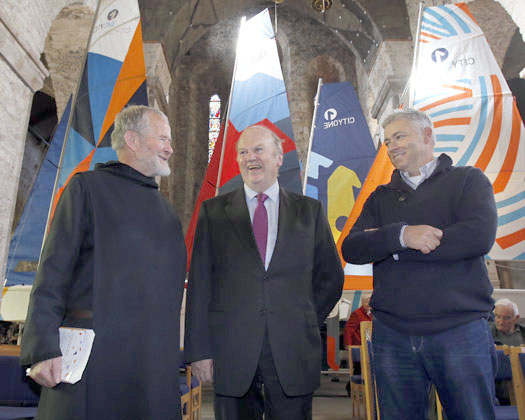
The hopeful new spirit of Irish sailing in 2014 was evident in St Mary's Cathedral in Limerick, when the CityOne dinghies built by volunteers in an inner city revitalisation project went on display in a Naumachia in the Cathedral on September 26th, after their first regatta on the Shannon in the heart of Ireland's City of Culture 2014. With the boats in the cathedral were (left) Brother Anthony Keane of Glenstal Abbey (Director, the Ilen School), Limerick's senior TD and Ireland's Minister for Finance Michael Noonan, and Gary MacMahon (right) Director of the Ilen School & Network for Wooden Boatbuilding. Photo: Press22
And then more vigorous winds returned in October, with the Freshwater Keelboat event on Lough Derg – originally just an exclusive Dragon thing – finding itself swamped with sixty and more boats from five classes and increasingly rugged conditions, such that only the Dragons and Squibs managed to get in any meaningful racing, with Neil Hegarty (RStGYC) winning the Dragons while James Matthews and Rob Jacob of Kinsale topped the Squibs.

Dragons in Autumn action on Lough Derg – Neil Hegarty (right) was overall winner from runner-up Richard Goodbody (left) Photo: Gareth Craig
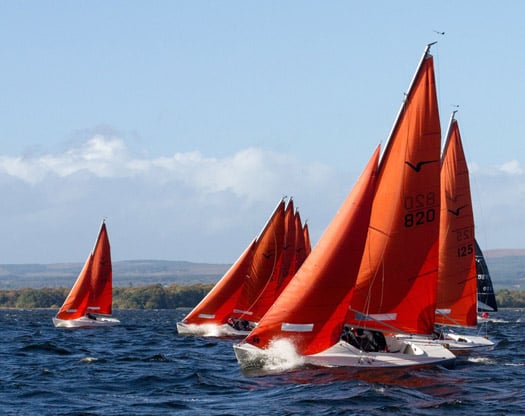
Squibs on Lough Derg – it may look like perfect sailing, but the top came off the weather very soon afterwads. Photo: Gareth Craig
The Student Yachting Worlds in La Rochelle in October had some hiccups in UCD's campaign for Ireland, but while they very narrowly missed the podium in a truly international event, they stayed put at fourth overall. And round in the Mediterranean, a record fleet for the Rolex Middle Sea Race from Malta saw entries soar through the 120 mark for the first time, and the 606 mile race had its first half in light breezes, but the second half was in pure Mistral, with people talking of "winds easing to 44 knots....." A Maltese-owned J/122 won, but second overall and first in her class was the Xp44 XpAct (Josef Schultheis) with a strong Irish emphasis in her crew including Barry Hurley, Andy Boyle, Kenny Rumball and Phillip Connor.
Soon afterwards, the Volvo World Race got under way with first stage from the Med to Cape Town, and Ireland's Justin Slattery on the winning boat on Leg 1. Back home, Autumn leagues had seen renewed enthusiasm as though people had suddenly re-discovered their sport, and the great sailing year of 2014 drew towards its close with the Lasers in Howth starting their 40th winter of annual frostbite racing. This means that HYC have now had a continuous sailing programme since April 1974, while across in Dun Laoghaire the DMYC Frostbite Series must be the most senior of all winter events. Winter Leagues attract more aficionados, with the popularity of the Dublin Bay Turkey Shoot in particular providing a forceful reminder that Dun Laoghaire is the principal sea access for a notably affluent and very large population in South Dublin. With the Turkey on its way, soon it's Christmas. And then the new Irish sailing season will begin on the blue waters of Sydney Harbour.
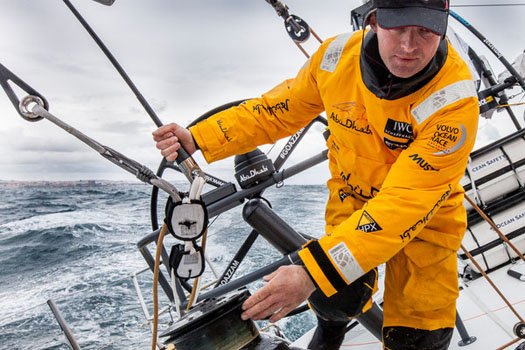
Justin Slattery on Volvo World Race 2014. Photo: Volvo Ocean Race
Body Recovered Off Howth Pier
#Howth - BreakingNews.ie reports that a body has been found near Howth Pier earlier today (Tuesday 11 November).
Though the identity has not yet been confirmed, gardaí said they have since stood down their search in tandem with Howth Coast Guard for missing 38-year-old Catherine O'Reilly.
The Clontarf woman was last seen on Thursday (6 November), and her car was found at the pier yesterday afternoon.
Round Ireland Yacht Race – Where Next? What Next?
#roundireland – The biennial Round Ireland Race from Wicklow is the jewel in Ireland's offshore racing crown. It may only have been established as recently as 1980, but now it is a classic, part of the RORC programme, and an event which is very special for those who take part. In fact, for many Irish sailing folk, having at least one completed Round Ireland Race in your sailing CV is regarded as an essential experience for a well-rounded sailing life. Yet despite fleets pushing towards the 60 mark in the 1990s, even before the economic recession had started tobite the Round Ireland numbers were tailing off notwithstanding the injection of RORC support, and the more recent bonus of it carrying the same points weighting as the Fastnet Race itself. At a time when the basic Fastnet Race entry list of 350 boats is filled within six hours of entries opening for confirmation, and when the Middle Sea Race from Malta has confidently soared through the 120 mark, while the 70th Sydney-Hobart Race in seven weeks time will see at least a hundred entries, the Round Ireland Race fleet for 2014 was only 36 boats, of whom just 33 finished. W M NIXON wonders how, if at all, this situation can be improved.
"The Round Ireland Race is the greatest. Why don't more people know about it? Why aren't there at least a hundred top boats turning up every time it starts? It's a marvellous course. We had great sailing and great sport. Can somebody tell me why a genuine international offshore racing classic like this has been going on for 34 years, and yet in 2014 we see an entry of only three dozen boats?"
The speaker isn't just any ten-cents-for-my-opinion waterfront pundit. On the contrary, it's Scotsman Richard Harris, skipper and part-owner with his brother of the potent 1996 Sydney 36 Tanit, the overall winner of the Round Ireland Race 2014. And he's asking these questions as someone who has raced with success in both the Fastnet and Sydney-Hobart Races, and has campaigned his boat at the sharp end of the fleet with the RORC programme from the Solent, and in any worthwhile offshore racing he has managed to find in his home waters of Scotland.
Harris is getting into fine form, as we're at the Tanit table for Wicklow Sailing's Club's Round Ireland Prize-giving Dinner-Dance in the Grand Hotel in Wicklow town last Saturday night. With a boxload of trophies for Tanit to collect, anyone would be in exuberant spirits. But his views on the quality of the Round Ireland Race are clearly thought out and genuinely held, and he is enthusiastically supported by his navigator, Richie Fearon.
Fearon is the man to whom the Tanit crew give the lion's share of the credit for their success, which was achieved by just six minutes from Liam Shanahan's J/109 Ruth from the National YC in Dun Laoghaire. He was the only one in Tanit's crew who had done the race before, and in an all-Clyde lineup, his was the only Irish voice, as he sails from Lough Swilly YC in Donegal. His previous race was in 2010 with the Northern Ireland-based J/124 Bejaysus (Alan Hannon), which finished 7th overall. But for the Derry man, second time round made the course if anything even more interesting.
"You get a wonderful sense of the race progressing all the time, of moving along the course" says Fearon. "In the Fastnet, for instance, there are periods when you feel as though you're sailing in a sort of limbo. But in the Round Ireland, you're always shaping your course with the next rock or island or headland or wind change or tidal time in mind. There's a fascinating and challenging mix of strategy and tactics and navigation and pilotage, all of which results in one of the most interesting distance races in the world. They really should get more people to do it. It gives a wonderful feeling of achievement and completeness when you just finish the course. And it's even better if you do well, as we felt we'd done in 2010. But believe me, winning overall, and in a boat as interesting as this with a crew of guys as good and as friendly as this, that's the best of all!"
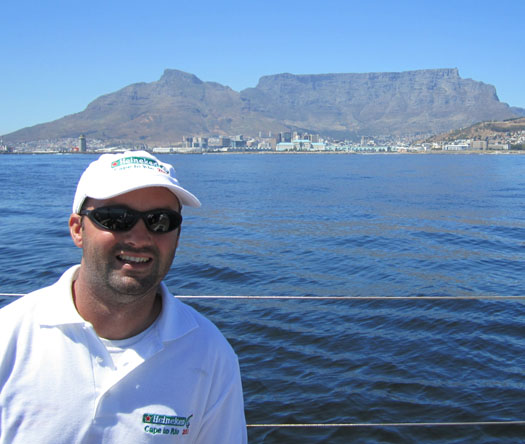
Richie Fearon of Lough Swilly YC, seen here kitted up off Cape Town for the Transatlantic race to Rio, navigated Tanit to the overall victory in the Round Ireland 2014
So how do you explain to such people, people who have become Round Ireland enthusiasts with all the zeal of recent converts, just why it is that Ireland's premier offshore event can barely attract a viable quorum when the yacht harbours of Europe are bursting with high-powered offshore racing boats which are constantly on the lookout for events worthy of their attention, not to mention commercial offshore racing schools and training programmes which need events like the Round Ireland Race to stay modestly in business?
How indeed, when we already have enough difficulty in explaining it all to ourselves. Inevitably, we have to look at the history, and the setting of that history. The last time I was at the Round Ireland Prize-Giving Dinner-Dance in Wicklow, there'd been enough participants from my home port of Howth in that year's race to make it worthwhile for us to hire a bus to go down through the Garden County for the party. We were in the midst of the Celtic Tiger years when people's expectations were becoming very pretentious, and I remember two foodies seated nearby in the bus pompously hoping to high heaven that the evening's meal wouldn't be the inevitable rural feast of beef or salmon.
But the charm of Wicklow town is that, though it's barely a forty minute drive from the capital, it is very much of the country - l'Irlande profonde as you might say. 'Tis far you are from big city notions of fancy menus to appeal to jaded metropolitan taste-buds. So it was indeed beef or salmon. Not that it really mattered that much to the crowd on the bus from Howth. They were well fuelled with on-board liquor by the time we got there, and the return journey in the small hours was made even longer by the need for frequent comfort stops, thus all they'd needed in the meal was absorbent food to mop up the booze.
Some things have changed greatly in the past few years, not least that there was so little Howth involvement in 2014's race that one very modest car would have done to get all the participants to last Saturday night's prize-giving dinner dance in Wicklow. But some things, thank goodness, don't change. It was still beef or salmon. And very good it was too, as salmon is excellent fish if you don't try to pretend that it's steak and grill it. That brings out its least attractive taste elements. But a baked darne of salmon with a well-judged sauce, such as we had last Saturday night, is a feast for a king. And I gathered the roast beef was very good too.
But it all reinforced the feeling that we were in the biggest hotel – the only hotel? - in a small Irish country town. Yet apart from the sailors at the night's event, there was nothing to suggest that Wicklow is a port, for there's something about the layout of the place which makes the harbour waterfront wellnigh invisible unless you seek it out. It's a delightful surprise when you do find it, but it's very much a little working port, rather than a natural focus for recreational boating and the biennial staging of one of the majorevents in the Irish sailing calendar.

You almost have to take to the air to see that Wicklow is a little port town, for as this photo reveals, the main street turns its back very decisively on the workaday harbour in the Vartry River.
It was back in 1980 that Michael Jones of Wicklow Sailing Club took up boating magazine publisher Norman Barry's challenge for some Irish boat or sailing club, any maritime-minded club at all, to stage a round Ireland race. Jones went for the idea, and Wicklow have been running it every other year ever since. It may be the jewel in Irish offshore sailing's crown. But in Wicklow's little sailing club, it is the entire crown, and just about everything else in the club's jewel and regalia box as well.
Whether or not this is good for the general development of sailing in Wicklow is a moot point, but that's neither here nor there for the moment. What matters is that as far as the growth and development of the Round Ireland Race is concerned, in the early days of the 1980s the fact that Wicklow was a basic little commercial and fishing port with only the most rudimentary berthing facilities for recreational boating didn't really matter all that much, as most other harbours in Ireland were no better.
In 1982, the great Denis Doyle of Cork decided to give the race his full support with his almost-new Frers 51 Moonduster. Denis was someone who strongly supported local rights and legitimate claims, and he reckoned that the fact that Wicklow Sailing Club had filled the Round Ireland Race void, when larger longer-established clubs of national standing had failed to step up to the plate, was something which should be properly respected. So in his many subsequent participations in the Round Ireland Race, Moonduster would arrive into Wicklow several days in advance of the start, she would be given an inner harbour quayside berth of honour in a place as tidy as it could be made in a port which seems to specialise in messy cargoes, and Denis and his wife Mary would take up residence in a nearby B & B and become Honorary Citizens of the town until each race was started and well on its way.
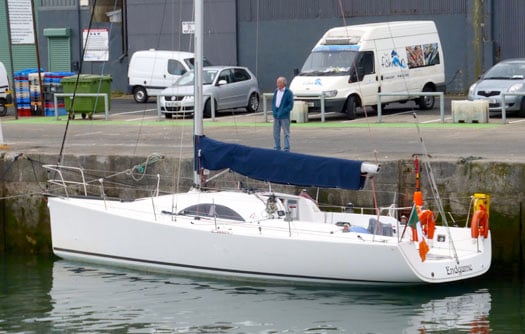
Like father, like son. Denis Doyle's son Frank's A35 Endgame from Crosshaven berthed in Wicklow waiting for the start of the Round Ireland Race 2014, in which she placed fourth overall and was a member of the winning team for the Kinsale YC Trophy. Photo: W M Nixon
It was an attitude which they brought to every venue where Moonduster was raced. The Doyles believed passionately that boosting the local economy should be something that ought to be a priority in any major sailing happening, wherever it might be staged. Denis had been doing the biennial Fastnet regularly for many years before he took up the Round Ireland race as well, and for a longtime beforehand he and Mary had also had the Honorary Citizen status in Cowes, as he would make a job of doing Cowes Week beforehand, living in digs in the town, while at race's end in Plymouth, there'd be a local commitment as well, albeit on a smaller scale.
This was all very well for Wicklow and the Round Ireland in the circumstance of the 1980s, but by the 1990s other ports were developing marinas and providing convenient facilities, yet Wicklow stubbornly stayed its own friendly but inconvenient self. When we look at the geography of the harbour, we can see why, and see all sorts of things that might have been done differently a very long time go.
For instance, when the Vikings were first invading and intent on making Wicklow one of their key ports, it could have been developed in a much more useful way if only the native Irish had made them welcome. Can't you just see it? "We'll overlook the rape and pillage for now, lads, these guys represent substantial inward investment". Just so. Had there been that far-sighted attitude, the locals could have invited the men in the longships to come on up the River Vartry, and into the magnificent expanse of the Broad Lough. What a marvellous vision that would have revealed. With some minor rock removal and a little bit of dredging in the entrance, it could be a wonderful extensive natural harbour in a beautiful setting. Had that happened, just think how differently the facilities of modern Wicklow harbour might now be.
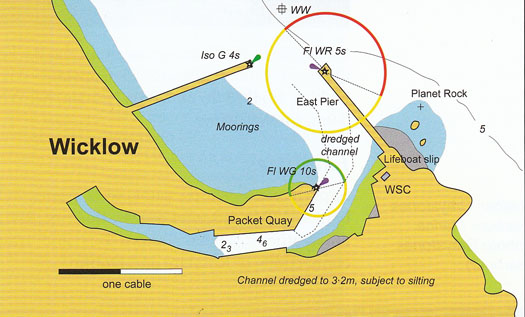
The navigable part of Wicklow Port as it is today. The water does not really come to a sudden straight-line stop as shown on the left – that's just the bridge. Plan courtesy Irish Cruising Club
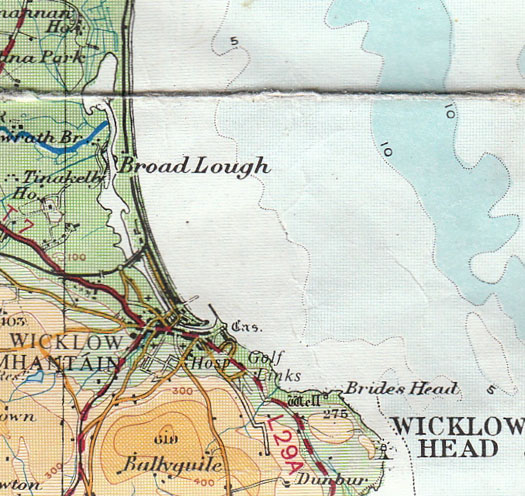
The bigger picture. Had the Vikings not been stopped such that they had to establish their settlement at the mouth of the Vartry River, they might have been able to create a much larger harbour settlement further in around the shores of the Broad Lough, with obvious advantages for Wicklow Port as it might have become today
Instead, the Vikings struggled ashore on the first available landing place at the first bend of the river, and established a beach-head which became such a successful little fort that eventually they were able to burn their boats. But by thattime, they were totally committed to having Wicklow town in its present cramped location. Access to the Broad Lough at high water (there's a very modest tidal range tidal) was soon restricted by the bridge, and then other river crossings, such that today nobody thinks of it as a potential harbour at all, if they ever did.
But meanwhile the current inner harbour is a cramped and dirty river which seems to be ignored by the town as much as possible, such that even the Bridge Tavern, the birthplace of Wicklow's most famous seafarer, Captain Robert Halpin of SS Great Eastern and trans-oceanic cable laying fame, turns its back firmly on the port. And as for the outer harbour, while it's a delightful place on a summer's day, it is not a serious proposition for berthing a large fleet of boats preparing for a major 704-mile offshore race, but people have to make do with it as best they can.
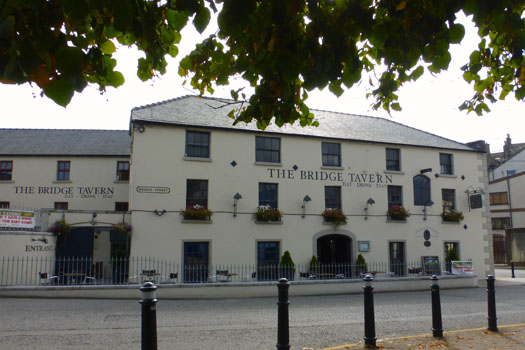
Despite being the birthplace of the most famous Wicklow seafarer, Captain Robert Halpin, the Bridge Tavern turns its back on the harbour. Photo: W M Nixon
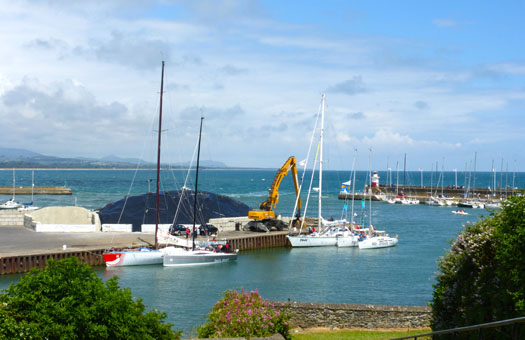
Wicklow's Outer Harbour on the morning of the Round Ireland race 2014 is a lovely sunny spot..............Photo: W M Nixon
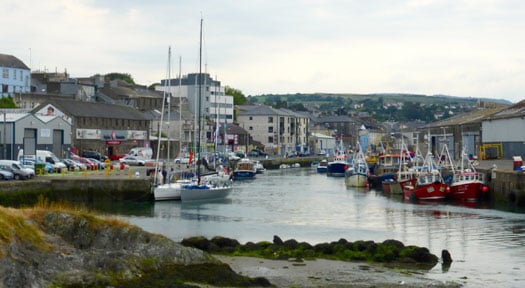
....but it is the inner harbour, shared with fishing and other commercial craft and assorted non-maritime quayside businesses, which will shelter the fleet preparing for the Round Ireland Race. Photo: W M Nixon
It was in the 1990s when the Round Ireland fleet was at its peak that the problems with the harbour's limited facilities were at their most acute, and it may be dormant memories of those difficult conditions which contribute to today's shortage of enthusiasm for the race. Back in the 1990s, the average cruiser-racer was not kitted out as a matter of course to RORC requirements, thus those undergoing their first scrutiny in order to be allowed to race round Ireland had to get to Wicklow several days in advance, and then often spendmoney like water to get up to scratch, the necessary bits and pieces being supplied by chandlers' vans parked on the quay.
It was crazy, not unlike a waterfront version of Ballinasloe Horse Fair - all that was missing was Madame Zara in her shiny caravan giving out nautical horoscopes in sepulchral tones for the wannabe Ireland circumnavigators. Perhaps she was there, but the two times I was going through the process with my own boat, it was so hectic I wouldn't have noticed. All I wanted to do was get to sea and away on the race, and get the filth of Wicklow harbour washed off the boat as soon as possible, as we'd drawn the short straw and had been berthed right in against the quay, so everyone has used our boat as a 35ft doormat on their way across to their own craft.
But the finish of the race at Wicklow – now that was and is completely different. The place seems to have transformed itself while you've been away bashing through sundry waters and a lot of the Atlantic in the intervening five days. Everyone is feeling like a million dollars, and Wicklow seems the only proper place in the whole wide world to finish a major offshore race. And as for the Round Ireland Prize Giving Dinner Dance, the venue of the Grand Hotel and beef or salmon for the meal is all part of the formula, it's central to the mystique of this extraordinary event.
In the days of the big entries with massive sponsorship from Cork Dry Gin, the prize-giving was Dublin-centred even if the race had started and finished in Wicklow. And the big bash in the city would start with a huge reception leading on into a gala dinner (I don't remember much dancing) in a glitzy Dublin hotel. In truth, it seemed a bit remote from little boats making their ways alone or in ones and twos back into Wicklow after the profoundly moving experience of racing right round our home island.
By the time you'd done all that, only others who have done the same could truly share your feelings about the experience. Big parties in anonymous city hotels were not the ideal setting for the Autumnal prize-giving and de-briefing. Thus the contemporary final hassle of getting down to Wicklow for the Round Ireland Dinner on a black November night in a veritable deluge of a downpour could be seen as the last stage of a long weeding-out process.
But once you're into the Grand Hotel and the party is under way, it's magic and the camaraderie really is quite something. Old rivalries and grievances fade away. It is also, to a remarkable extent, a family gathering – the number of family crews involved is surely exceptional. And the tone of it for 2014 is set by the presence of the winner of the KYC Trophy for the best three boat team, for the winners had as their top-placed boat the A35 Endgame, fourth overall and owner-skippered by Frank Doyle RCYC, son of Denis and Mary Doyle.
However, inevitably the status of the race and its future development and expansion is something which just won't go away. Any doubts about its importance were soon dispelled by considering the special guests at the dinner, as they included the President of the Irish Sailing Association David Lovegrove, the Vice Commodore of the Royal Ocean Racing Club Michael Boyd of the RIYC, and the Commodore of the Royal Irish Yacht Club, Jim Horan, whose club in 2014 was for the first time in association with Wicklow Sailing Club on the Round Ireland Race. The RIYC acted as hosting club in Dun Laoghaire for visiting boats which didn't want to go on down to Wicklow until shortly before the start, but wished toavail of modern marina facilities and the amenities of a large sailing port in the meantime.
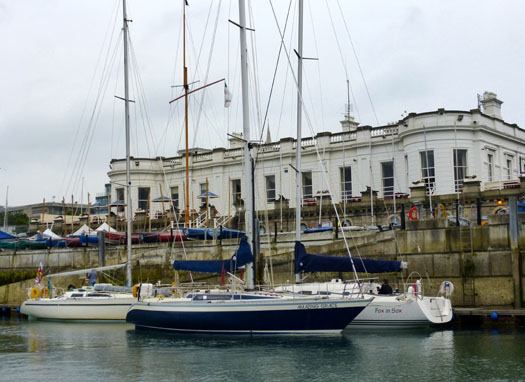
The switched-on crews going to Dun Laoghaire before the start of the Round Ireland Race 2014 knew that the best approach was to make themselves known at the Royal Irish YC and get a berth there, instead of allowing their boats to be banished to the "Siberia" of Dun Laoghaire Marina's remote visitors berths. Photo includes the MG38 McGregor IV from Essex which finished tenth overall (left), and the Oyster 37 Amazing Grace from Kerry, which had been in the frame but was forced to retire with equipment failure. Photo: W M Nixon
It was a partnership with potential, but it will need to be worked on. For although boats from other parts of Ireland knew that on arrival in Dun Laoghaire the secret of being well looked after was to make your number directly with the RIYC, boats from further afield coming into Dublin Bay tended to contact the marina, and thus they were stuck into Dun Laoghaire Marina's absurd visitors' berths, which are right at the very outer end of the pontoons, way out beyond acres of currently empty berths, such that it's said that anyone on them is one whole kilometre's walk from dry land.
Before the Round Ireland Race, the eventual winner Tanit was brought up from the Solent to Dun Laoghaire by a delivery crew who contacted the Marina Office, and she was stuck out in the Siberia of those Visitors Berths. It did mean that when she was first properly seen in Wicklow Harbour on the morning of the race, her impact as clearly an extremely attractive and very sound all round boat was all the greater. But nevertheless, if that is Dun Laoghaire Marina's idea of making visitors welcome, then they need to do something of a reality check, and it was a telling reminder that many Dun Laoghaire and Dublin Bay sailors are so absorbed in their own clearly defined and time-controlled activities afloatthat it leaves them with only limited attention for events outside their own sphere of interest.
As for Dun Laoghaire's general public, is there any interest at all? If the start of the Round Ireland Race was shifted to Dun Laoghaire, as some suggest, do you think the vast majority of the locals would take a blind bit of notice? At least in Wicklow they do make a bit of a fuss on the day of the start, with a community-sponsored fireworks display the night before.
In a final twist, in setting up the new Wicklow-Dun Laoghaire relationship, nobody had thought of the Greystones factor. Most had been unaware that the new Greystones marina is unexpectedly very deep. But such is the case, as I learned on Saturday night from the man from Newstalk. It's one of the reasons it cost the earth to build the little place. But it did mean that, in the buildup to the Round Ireland Race, while two of the deepest boats, the Volvo 70 Monster Project chartered by Wicklow's "Farmer" David Ryan, and the Farr 60 Newstalk, were unwilling to berth in Wicklow itself, they'd only to go a few miles north to find a handy berth in Greystones, where they were still very much in Wicklow county. There, they were the focus of much attention. For as we've discovered at Afloat.ie, if we lead a story #greystones, the level of interest is amazing.
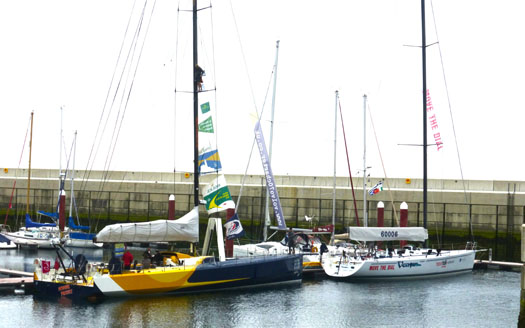
The exceptionally deep water in Greystones Marina provided trouble-free berthing for the Volvo 70 Monster Project and the Farr 60 Newstalk. Photo: W M Nixon
Perhaps after their attendance at the Round Ireland Dinner in Wicklow last Saturdaynight, Tanit's crew now have a better understanding of why the Round Ireland Race is in its present format. And I certainly understand why the level of close personal attention which goes into the race administration by the small team in Wicklow SC running it adds greatly to its appeal for dedicated participants. Before going to Wicklow, I'd been checking with the eternally obliging Sadie Phelan of the race team whether or not Richard Harris would be there, as I had to admit I thought his boat was only gorgeous. "Of course he'll be there" says Sadie, "and I'll put you at his table".
Not only that, but the winner Tanit's table and the runner-up Ruth's table were cheek by jowl, so much so that I was almost sitting at both of them. It would have taken a team of scribes to collate all the information flying back andforth, but everything was of interest.
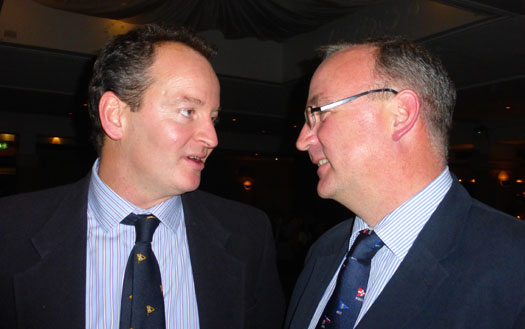
Just six minutes separated them at the end.....winner Richard Richard Harris of Tanit (left) and runner-up Liam Shanahan of Ruth at the Round Ireland prize-giving in Wicklow last Saturday night. Photo: W M Nixon
Richard (42) and his brother have owned Tanit for about twelve years, but as his brother is into gentler forms of sailing, the offshore campaigns are exclusively Richard's territory. In early sailing in the Clyde, they'd campaigned a Sweden 36 with their late father while Richard's own pet boat was a classic International OD. But as his interest in offshore racing grew, heidentified the Australian Murray Burns Dovell-designed Sydney 36 as ideal for their needs. He found there was only one in Europe, a 1996 one, little-used and in the Solent. They soon owned her, and changed her name to Tanit as the family firm is Clyde Leather, a vibrant firm which is the only suede tannery in Scotland.
Thus as raced in the Round Ireland, Tanit had the logo of Clyde Marine Leather on her topsides - a useful sideline is suede products for marine use, including a very nifty range of attractively-priced DIY kits for encasing your stainless-steel steering wheel in suede. Show me a boat which has a bare steel wheel, and I'll show you a boat which is on auto-pilot for an indecent amount of the time. But if you are doing the suede coat thing on your helm, be sure to cover the spokes as well, it makes all the difference for ultimate driver comfort.
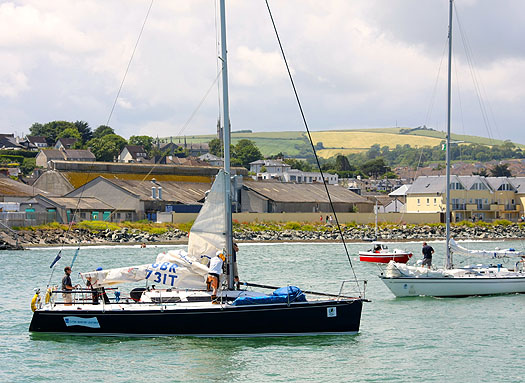
The boat from God knows where....Tanit (left) was an unknown quantity when she made her debut in Wicklow Harbour on the morning of the Round Ireland Race 2014, but father and son crew Derek & Conor Dillon's Dehler 34 Big Deal (right) from Foynes had already taken part in a couple of ISORA races, and went on to win the two-handed division and place 8th overall. Photo: Kevin Tracey
Gradually, they built up Tanit's campaigning in the Clyde, and most of the crew who currently race the boat have been together for seven years. They also chartered a boat to do the Hobart Race of 2008, but as Scottish offshore racing numbers declined, they decided to give it a whirl with the RORC fleets in the English Channel by moving Tanit down there. They found that the programme of concentrated doses of large-fleet intense offshore racing, all taking place at a venue two hours' flight from Glasgow, suited them very well – they could be totally domesticated when at home without the distraction of the boat being just half an hour's drive down the road.
The Sydney 36 of Tanit's type ceased production in 1997, the Sydney 36 you'll tend to come across now on Google is a new 1998 design. So when Tanit's rudder was wrecked after the 2011 Fastnet (a good race for them), it was something of a disaster as a replacement rudder could no longer be supplied off the shelf. It was even more of a disaster for the unfortunate woman who was driving her five-day-old Range Rover around the boatyard in Southampton where Tanit had been hoisted after returning from the Fastnet finish in Plymouth, for not only was her absurdly big shiny new vehicle severely damaged in somehow colliding with the rudder of the Scottish boat, but it turned out that an inevitably custom-built replacement would cost a cool 35K sterling for her insurance company, as that was one very special rudder.
It was a disaster all round, for by the time they'd identified a high tech builder of sufficient repute prepared to build the new rudder, they had missed most of the 2012 season. Then the 2013 Fastnet Race had too much reaching to suit them, as Tanit is at her best upwind and down. So with Richard's brother making louder noises about selling Tanit in order to suit his more sybaritic preferences afloat, the Round Ireland Race 2014 came up on the radar as being an opportunity for what might well be the last hurrah with a much-loved boat.
They needed a navigator, and preferably one with some experience of the Round Ireland course. Fortunately John Highcock of Saturn Sails in Largs, who regularly races with Tanit as one of those ace helmsmen who can seem to smooth the sea, had sailed with Richie Fearon and suggested him with the highest possible recommendation, so the Swilly man was brought on board.
The rest of the crew were complete round Ireland virgins, but they found the race suited their style and level of sailing very well indeed. In any Round Ireland Race, seasoned observers can usually identify beforehand the half dozen or so boats which will be serious contenders for the overall handicap prize, but which one actually wins will depend on the way the chips fall. But Tanit was something of an unknown, a wild card. Yet it wasn't very far into the race before it became clear that this was a good boat on top of her game, if things came right she'd the makings of a winner.

Tanit settling in after the start. The quicker they got south, the sooner they got back into the sunshine........
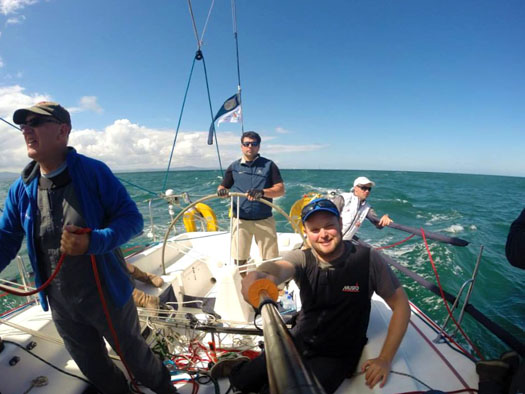
....and nearing the Tuskar Rock on the Saturday evening, they were back in sunshine, and well in contention on the leaderboard.
Within the limits of having a sensible boat which professionals would describe as a comfortable cruiser-racer, they campaign flat out. All meals are built around expeditionary and military Ration Packs, which can be quite expensive to buy in ordinary circumstances, but if you can show they're going to be used for a worthy objective, it's possible to swing a deal, and as Richard's wife Vicky is a physiotherapist who is involved with military reserves, the value of Tanit's campaigns is accepted in the right places. The result is a nourishing supply of reasonably attractive easy-prepare instant food which, as Richard reports still with some wonderment, makes no mess at all in and around the galley, yet keeps the crew on full power.
By the time they got up off the Donegal coast, Tanit was right in there, battling with the defending champion, the Gouy family's Ker 39 Inis Mor, for the overall handicap lead, while up ahead the two biggies, Teng Tools (Enda O'Coineen and Eamonn Crosbie) and the Volvo 70 Monster Project, with David Ryan of Wicklow, kept finding new calms as they tried to shake off the smaller craft.
It was a slow race, but Richie Fearon managed to place Tanit so that she stayed ahead of a calm up in his home waters, and was keeping station on Inis Mor very handily indeed, while the gap with boats astern widened all the time. Or so it seemed. But then the Round Ireland Race pulled one of its regular tricks, and Liam Shanahan and his team on the J/109 Ruth began to shift before they'd even got past Tory Island, and they appeared to carry a useful breeze and a fairtide the whole way from Donegal into the Irish Sea, or at least that's how it looked to the rest of the fleet.
But in closing in over the final stage from Rockabill to Wicklow, navigator Fearon – who was incubating a nasty virus which required antibiotic treatment for a week after the race - convinced Tanit's skipper that they should stay offshore, while Ruth – which seemed to have the race nicely in the bag – followed the Irish habit of hugging the coast. Inis Mor was already finished on Friday morning, but Tanit knew she was beatable by them, and when they came across the line at 1030, it was to move into the CT lead. And going offshore proved to have been their win move.
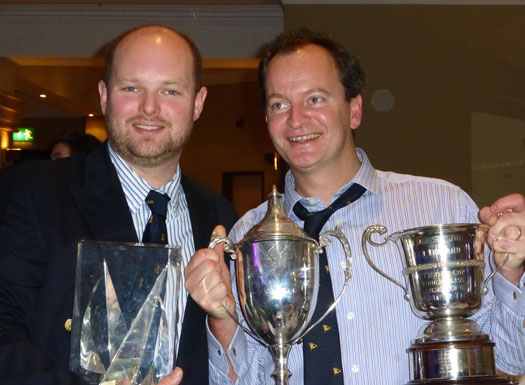
Trophies of the chase – crewman Chris Frize (left) and skipper Richard Harris with some of Tanit's prizes in Wicklow last Saturday night. Photo: W M Nixon
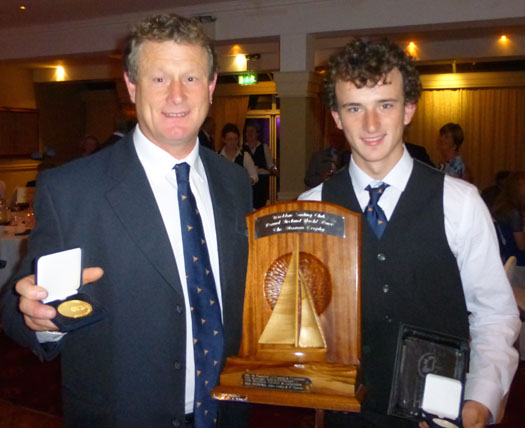
Family effort. Father and son team of Derek and Conor Dillon from Listowel in Kerry (they sail from Foynes) won the two-handed division with their Dehler 34 Big Deal, and placed 8th overall. Photo: W M Nixon
It was a time of screaming frustration for Ruth. She'd been crawling along near Bray Head, barely 15 miles from the finish, as long ago as 0700. She rated only 1.016 to the 1.051 of Tanit. A finish in the middle of lunchtime would do fine. It was so near. It was so far. Finally they got to Wicklow, but Tanit had them beaten by six minutes. Then for the Scottish boat there was just the chance that Ian Hickey's very low-rated veteran Granada 38 Cavatina might do it again. But the wind ran out for her too. Meanwhile Frank Doyle's Endgame came in at mid-afternoon to slot into fourth on CT behind Inis Mor, but Cavatina was fifth, all of five hours corrected astern of Tanit. The Scottish boat was now unbeatable leader.
Tanit's crew for this classic sailing of a true offshore classic was Richard Harris, Richie Fearon, John Highcock, Alan Macleod, Chris Frize, Andy Knowles and Ian Walker. They've a lovely boat of which they're justifiably very fond, but reality has intruded, and now she is indeed for sale. The price is 48K sterling which seems to me very reasonable when you remember that she is remarkably comfortable to sail, that sails and gear have been regularly up-dated, and that we know for certain that the rudder alone is worth 35K.......She's conveniently located for an Irish potential owner, as she's currently ashore in Glasgow. Certainly she has a performance weakness, for as Richard admits, she'll easily get up to 7 knots on a reach, but stubbornly stays there and goes no faster, yet if you harden on to the wind, she'll still be doing 7 knots. But if you go downwind, then whoosh – it's a horizon job on most other boats. Be careful what you wish for, though. With a boat like Tanit in an average fleet, there'll be no excuse for not doing well......
The rest of the trophy placings are here, and on Saturday night they were one lovely compact crowd of people. The family emphasis was inescapable, and it was a particular pleasure to meet the Kerry duo, father and son crew Derek and Conor Dillon from Listowel, who sail out of Foynes in their Dehler 34 Big Deal. In 2015, they plan to take on the two-handed division in the Fastnet, so getting 8th overall and winning the two-handed class in the Round Ireland 2014 was part of a very useful campaign trail.
Finally, as to how to keep the Round Ireland race's distinctive Wicklow flavour while allowing the entry numbers enough room to comfortably expand, it's such a tricky question that it will require a radical solution. A very radical solution. The mistakes of the Vikings must be undone. The Vartry entrance must be dredged, The bridges must all be removed. And the Broad Lough must be tastefully developed to give Wicklow the harbour it deserves, and the Wicklow Round Ireland Race the facilities it needs to cater for a fleet of a hundred and more boats. Simple, really.
ROUND IRELAND RACE TROPHY WINNERS 2014
Line Honours: Denis Doyle Cup - Monster Project (David Ryan, WSC)
IRC Class CK: CK Cup – Monster Project
IRC Class Z: Class Z Cup - Newstalk for Adrenalin (Joe McDonald, NYC)
IRC Class 1: Tuskar Cup – Inis Mor (Laurent Gouy, CBC)
IRC Class 2: Fastnet Cup – Tanit (R Harris, SYC)
IRC Class 3: Skelligs Cup – Ruth (L Shanahan, NYC)
IRC Class 4: Tory Island Cup – Cavatina (I Hickey, RCYC)
Class 5 (Cruiser HF) – Cavatina
Class 6 (pre 1987) Michael Jones Trophy – Cavatina
Class 7 (two-handed) Noonan Trophy – Big Deal (D & C Dillon, FYC)
ICRA Trophy (best Irish boat) - Ruth
Ladies Award: Mizen Head Trophy - Pyxis (Kirsteen Donaldson)
ISORA Award – Ruth
Team Award: Kinsale YC Cup – Endgame (F Doyle), Wild Spirit (P Jackson) & Fujitsu (D B Cattle).
IRC Overall: Norman Barry Trophy – Tanit
Round Ireland Overall: Wicklow Cup - Tanit

Monster boat, monster prizes. Line honours and Class C winner David Ryan of Wicklow, who raced the Volvo 70 Monster Project to success, with Roisin Scanlon, also WSC, who crewed on the Monster during the Round Ireland Race Photo: W M Nixon
Marine Notice: Site Investigation Works At Howth Fishery Harbour Centre
#MarineNotice - The Department of Transport, Tourism and Sport advises that site investigation works will commence at Howth Fishery Harbour Centre on or around today 29 October, weather permitting.
The works, involving geotechnical investigations within the western trawler basin, are being advanced by a site investigation crew working from a jack-up barge 11m × 6m in size, using engineering plant and machinery and work vessels.
For safety reasons, mariners are requested to proceed slowly and with caution in the approach to the western trawler basin of the Fishery Harbour Centre and to give the site investigation works a wide berth. Wave-wash from vessels should be avoided.
These works are expected to be ongoing until 19 November, weather permitting. For further information, contact the Howth Harbourmaster’s Office at 01 832 2252.
Howth Yacht Club Autumn League Counts Down to Saturday Climax
#hyc – Howth Yacht Club's (HYC) leaderboard showed some small changes to the leaderboards yesterday within the nine classes, but no change to the idyllic conditions after week five of the MSL Park Motors Mercedes-Benz sponsored event that has enjoyed for every day of the event so far. With one last race to go, some of the divisions show clear winners, but most will see the overall results decided next Saturday when the series is completed.
In the one-design keelboat fleet, John Phelan and his team on their J80 lead that class after their second win in a row, but only by 2 points from the Flynn-Buckley team. A first place in the Puppeteer Class for Alan Pearson and team on his Trick or Treat won't be enough to threaten the lead of the Walls-Browne partnership and crew on Gold Dust. Their 3 wins earlier in the scratch series will prove to be unassailable when the results emerge even after next week's race. Cyprian Feeley's Cloud 9 will have to be struck by very bad luck if Ibis manages to catch up in the Puppeteer handicap division, as Susan Sheridan's team will have to win next week and hope that Cloud 9 finishes in worse than 8th position if they are to sneak ahead.
With the class competing in next week's Freshwater Keelboat Regatta in Lough Derg, the Squib Class result is final with Fergus O'Kelly's Selik winning the scratch prize and Ronan MacDonell's Fantome victorious on handicap.
Brian and Conor Turvey's Isobel's won this week's Howth 17's race, positioning their classic one-design within 2 points of the leading boat - Marcus Lynch and John Curley's Rita. Deilginis sits one point behind in third, but the maths mean that they are now unable to win the overall next week. In their handicap division, Tom Houlihan's Zaida will surely have to give its all next week if they are to pass out the consistent Sheila, who's skipper Mary Faherty has put the youngest 17-Footer seven points ahead.
In Class 1 IRC, Norbert Reilly and Alan Chamber's win on Crazy Horse halted the seemingly unstoppable J109 Storm (Pat Kelly) who had to be content with a 3rd place following Ross McDonald's Equinox finishing 2nd. The Equinox crew will also have to settle for second in the ECHO division, as Storm's domination of Class 1 will now see its crew collect both IRC and ECHO overall prizes next week.
Despite a late charge by the Colwell-Cobbe owned Fusion, Anthony Gore-Grimes and his crew on Dux will certainly win the Class 2 ECHO prize at the end of the series, but they are being pushed all the way in the IRC division by Mike and Ritchie Evans' The Big Picture, followed one point behind by Jonny Swan and Peter Freyne's Harmony.
The closest leaderboard would appear to be in Class 3, with both IRC and ECHO divisions split by only a few points. Vince Gaffney's Alliance II is being pushed all the way by the J24s Scandal (Brian McDowell) and Kilcullen (HYC's Under 25 team) in IRC, while Scandal and Lionel McMurtry's Hellyhunter sit closely behind Kilcullen going into the last race.
Colm Bermingham and crew on Bite the Bullet won their race in Class 4 IRC, but Tiger (Stephen Harris and Frank Hughes) still lead by a slender margin of 2 points while David Sargent's Indulgence will win the ECHO prize next week. In Class 5 ECHO, Harry Byrne's Alphida and Gordon Knaggs's Jokers Wild are neck-and-neck going into the final race, but Kevin O'Byrne's Mary Ellen5(mathematically) could still manage to win. The Class 5 IRC division also sees Alphida in the running, but needs to catch leaders Jebus (Emmet Dalton) following their win this week.
In the Mini Series event, many of the existing leaders in the various classes remain on top of the results list, however Paul Colton's Cri-Cri has managed to make an impression in Class 3 and contends the lead in IRC while leading on ECHO. A 3-way tie in the Class 1 ECHO mini series between Crazy Horse, Dear Prudence (Patrick Cruise O'Brien) and Equinox will make for an exciting end to their racing next week.
This week's prizes were presented by MSL Park Motors Mercedes-Benz Business Development Executive Patrick Manning, who also clearly enjoyed taking part in the racing on board Declan Gray's Sapphire.
Howth's Maritime & Sailing History is Brought Centre Stage
#hyc – A new billboard on Howth Yacht Club's prominent gable wall has re-kindled local and general interest in the Fingal port's place in Irish and international sailing and maritime history. And it has led to an upsurge of warm local pride around Howth Harbour. After a summer visiting other ports, W M Nixon returns home and tells how it all came about, and of the re-vitalised seaborn sport which has resulted from this imaginative initiative.
The world's most historically interesting and best-preserved one design keelboat class is hidden in plain sight just 14 kilometres from the heart of Dublin. And at the entrance to the harbour where these very significant boats have their secret summer existence, there stands the most perfect little classic lighthouse you ever saw. It too is hidden in full view.
Or at least, it all seems virtually invisible for many of the folk who live in Howth, who have simply become so accustomed to the presence of the 1817-built lighthouse and the 1898-founded Howth Seventeen Class that they scarcely appear to notice them any more. They seem to take them for granted, as is the case many of the other special features of what is a remarkably successful fishing and sailing port.
Well, maybe they do take a little bit of notice. Certainly if some environment-altering project gets under way which doesn't meet with quiet general approval, you'd be surprised by the level of opposition which can be aroused, and with effect too. But it's part of Howth's reserved way of doing and seeing things not to make a song and dance about local features of importance and attraction when they are as they should be. For it is a fact that, well within living memory, Howth most certainly didn't exude prosperity. So the ingrained pessimism of a fishing port means that when things are going well and the place is functioning as it should, you just stay quiet and don't make a song and dance about the good times rolling.
Nevertheless, now and again when someone with experience of the outside world, and the standing to have opinions which matter, says that Howth is very special and it's time somebody said so, we're quietly rather pleased. And when it's done in in a way which has the style and effect of the new Mercedes-Benz billboard on the prominent gable wall of Howth Yacht Club, we're very pleased indeed.
This billboard encapsulates much that it is significant in the history of Howth Harbour, and it gets the spirit of the place. It shows four boats of the Howth Seventeen class (the "17" refers to their waterline length) gliding in close formation under their full jackyard tops'l rig into the harbour past the gem of a lighthouse in a photo which is so pin sharp that you can easily read the date plate of 1817 on the lighthouse.

The Howth Seventeens which made it to stardom are (left to right) Hera (Michael Duffy0, Oona (Peter Courtney), Isobel (Brian & Conor Turvey) and Aura (Ian Malcolm) Photo of David Branigan photo by W M Nixon
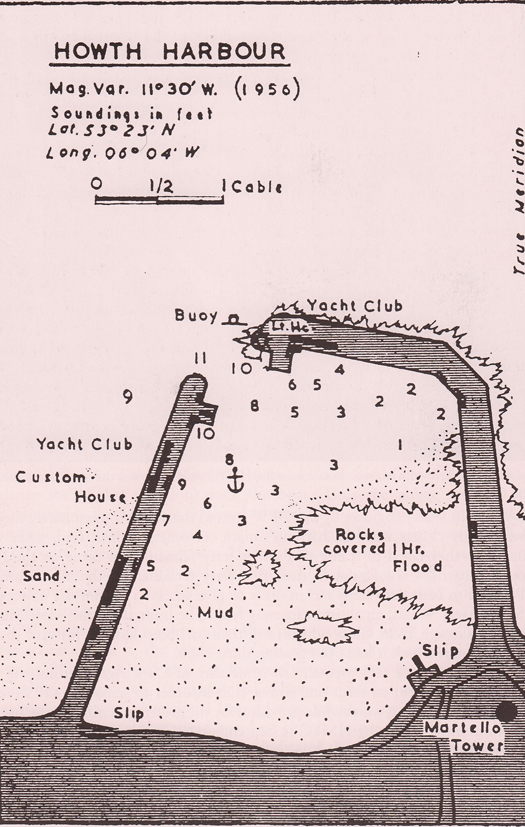
Howth was a distinctly disadvantaged port until relatively recently. Used as the main Dublin ferry port only between 1817 and 1826 (when Dun Laoghaire took over), it only became a "fishing station" around the 1840s-1850s. Then when the herring were fished out by the 1890s, some recreational boating space became available. But even by the late 1950s, as seen here, it was still a very limited harbour.
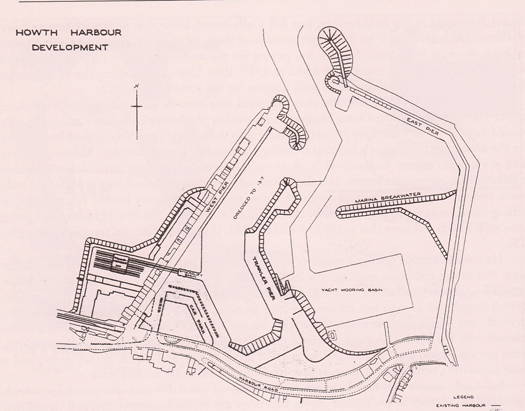
This outline plans for a major Howth redevelopment became available in the late 1970s. In those days, the very idea of a marina was anathema to some interests. So although a new breakwater is indicated as the "Marina Breakwater", the actual space in which Howth YC were to be obliged to install a marina at their own expense was only referred to as a "Yacht Mooring Basin".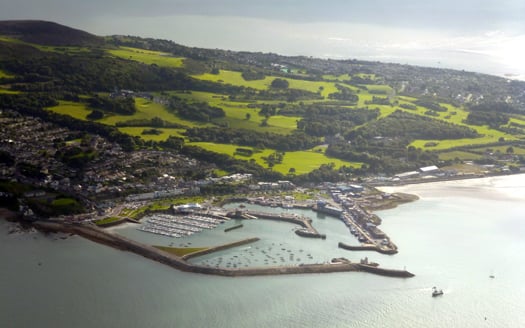
Howth Harbour as it is today, looking southwest across the peninsula with the waters of Dublin Bay at Sutton at top of photo. With clearcut boundaries between the different harbour uses, it has become a harmonious place. The presence of an active fishing port has led to a proliferation of good seafood restaurants. And the preservation of swinging moorings in the northeast corner of the harbour (foreground) has enabled the historic Howth 17s to survive and prosper. Photo: W M Nixon
The Howth Seventeens are part of Irish and international sailing lore. They still sail to the original design by Herbert Boyd of Howth House as signed off in October 1897, and they still race as keenly as they first did on May 4th 1898. More keenly, in fact - they currently have something like sixty races a year, and new boats and new owners and crews have lately been joining the fleet.
As to how they have acquired this overnight fame after 116 years, it's down to Stephen O'Flaherty of Mercedes-Benz. He brought together the needs of Howth YC for a sponsor for their Autumn League in concert with the fact that his quality marque sought a happy match with something which allied classic and timeless style, and could withstand the prolonged exposure of being on a highly visible billboard for the three years of the contract.
Working in close consultation with former and present HYC Commodores Derek Bothwell and Brian Turvey, the idea developed of a big screen photo which would encapsulate key aspects of Howth's unique maritime features in a clear and eloquent combination. Stephen O'Flaherty is owner of the achingly handsome Spirit 54 Soufriere, so he has an eye for a good-looking boat. And as a relative newcomer to being a Howth peninsula resident, he still sees it all afresh.
He pointed out that the little lighthouse at the end of the East Pier is still beautifully maintained, though it is now redundant as the working lighthouse is further north on the breakwater extension added in the early 1980s. Indeed, it is still even inhabited, and for many folk from elsewhere, that plucky little historic lighthouse symbolizes the spirit of Howth. It looks just as a lighthouse should, and it provides a perfect background for a sailing scene featuring the Howth 17s.
So all that was needed was a suitable day to get ace marine photographer David Branigan of Dun Laoghaire (who showed at last year's J/24 Worlds in Howth that he has a talent for drawing the locals' attention to the more picturesque aspects of their port and peninsula), line up half a dozen well-presented Howth Seventeens complete unto jackyard tops'ls, and get them in a harmonious arrangement with the lighthouse in the background and the flanks of the steep island of Ireland's Eye beyond, and lo and behold you have your magic picture, just like that.
Anyone who has ever tried to take a photo of just one boat sailing will realize what an extraordinary challenge this was, as even with one boat you're relying on the presence of a breeze, you're hoping for sunshine, and you're praying that when the best moment arrives, nobody will be standing up on deck or in the cockpit, or looking at the camera, thereby ruining the balance of the photo. And that's just with one boat.
Worse still, it all had to be brought together at very short notice. But the first day suggested for a photo shoot – Thursday August 28th and already under pressure with just two weeks and a couple of days to go to the start of the Autumn League – was a complete no-go with adverse conditions. Time was running out. It had to be Monday September 1st.
They had neither decent breeze nor sunshine on the day, and getting the Howth Seventeens to sail in concert is about as easy as herding cats. As for the wind, it was only fitful from the east, while to the inexperienced eye, the light seemed very flat, and no sunshine.
On top of that, team head Joanna Kavanagh of MSL had only been available on the Thursday – by Monday she was on another photo shoot in Portugal. But far from letting this get them down, the location team rose to the challenge. And the Howth Seventeen sailors gave of their best for a whole day. Show me a Howth Seventeen sailor, and I'll show you a ham......
In the cruel ways of Tinseltown, of the six Howth Seventeens which gave of their very best for that long and often frustrating day's shooting, two ended up on the cutting-room floor - Roddy Cooper's Leila and the Nick Massey syndicate's Deilginis. The final masterful Branigan photo shows Ian Malcolm's Aura (no 7) ahead of Peter Courtney's Oona (no 17), Conor and Brian Turvey's Isobel (no 19) and Michael Duffy's Hera (no 9).
As a sailing photo, it mightn't garner enough excitement to make it into a yachting magazine. But as a billboard designed to tell a story in a specific location, it tells ten thousand words, and tells them very well too. And as clearly as possible – Jason Hurley of Jason Hurley Designs, who was involved in the shoot, also cleaned up the raw photo afterwards to enhance it and take out stains from sails, scrapes from topsides, and weed from waterlines. When it went up just three days before the Autumn League was due to start on Saturday September 13th, it was to be greeted with a shared wave of enthusiasm of a kind which is rare enough in a quirky little community like Howth.
Needless to say, there were soon the usual quips to be heard. The Howth Seventeens survive through turning the laws of physics on their heads. Thus while energy creates friction for other folk, among Seventeen-footer persons it's friction which creates energy. There's nothing like a barbed remark or two to sharpen enthusiasm for the next race. So for those who have said that it takes a posed billboard photo to ensure that Ian Malcolm with Aura will be at the head of the fleet, let me say that in addition to winning races now and again, nobody else in the class has done as much to tell the world that the Howth Seventeens are alive and well and sailing more keenly than ever, and here's a selection of just some of the things that Aura has done in the last sixteen years:
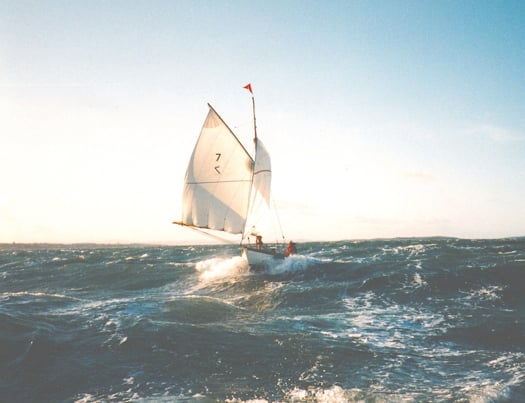
Aura goes offshore. In 1998, the Howth 17s celebrated the Centenary of their inaugural voyage from builder John Hilditch of Carrickfergus 95 miles non-stop back to Howth. Aura is seen here starting to get offshore off the County Down coast as a bright but very cold evening draws in on April 15th 1998. Photo: Damian Cronin
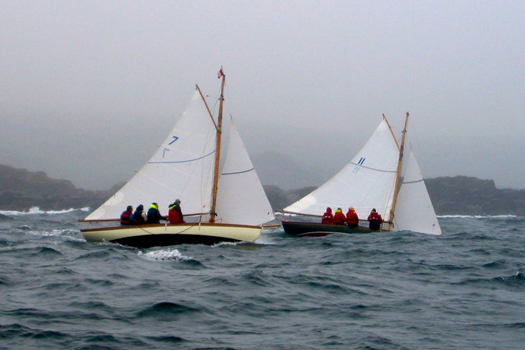 The Howth 17s make the scene at the Glandore Classics 2003 with a foggy race from Castlehaven to Glandore. Here, Aura is chasing Deilginis close inshore. The winner was the first boat to have a crewman downing a pint in Casey's bar in Glandore. Photo: W M Nixon
The Howth 17s make the scene at the Glandore Classics 2003 with a foggy race from Castlehaven to Glandore. Here, Aura is chasing Deilginis close inshore. The winner was the first boat to have a crewman downing a pint in Casey's bar in Glandore. Photo: W M Nixon

In 2008, Aura was the only Howth 17 to take part in the Waterways Ireland Classic Boat Regatta at Dromineer on Lough Derg. She is seen here sharing the lake with an International 12, Water Wags, Shannon One Designs and a Folkboat together with the 1873-built committee boat Phoenix (John & Sandra Lefroy). It was the first time a jackyard tops'l had been seen on Lough Derg since before the Great War of 1914-18, as the post-war fleet there were either gunter or Bermuda rigged. Photo: Gerardine Wisdom

Aura and Deilginis off the Royal Yacht Squadron Castle at Cowes in July 2013 during the Classic One Designs Regatta. It is thought to be the first time the Howth 17s were in the Solent. Photo: Mel Massey
As to the Howth Autumn league, it started 35 years ago in a low key sort of way, when the boats of the newly-formed Squib Class realized they'd been at full first season fleet numbers for only a few weeks, yet if they followed the local wooden-boat traditions, they'd soon be laying up. But the Squib is a minimal maintenance little 19ft keelboat, most of the boats were new in any case, and the Lasers had been having their annual winter series in Howth since October 1974. So the Squibs decided to tag themselves on to the Laser race officer team, and continue their sailing until early December, and thus was the Howth Autumn League born, though it didn't become a fully-fledged all-keelboat-classes business until the marina opened in 1982.
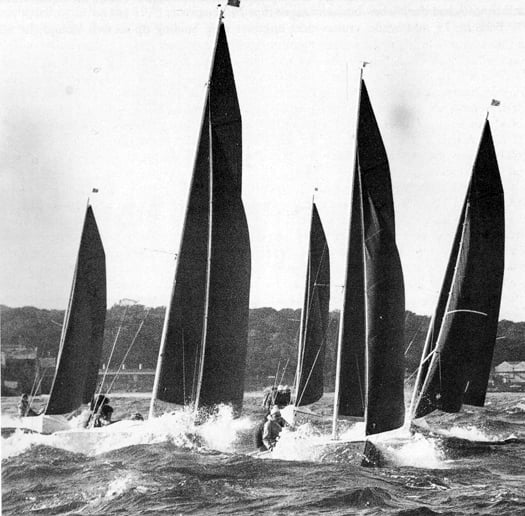 When it all started. The newly-established Squib Class inaugurated the Howth Autumn League in 1979, and this was the first race of that series. Photo: Jamie Blandford
When it all started. The newly-established Squib Class inaugurated the Howth Autumn League in 1979, and this was the first race of that series. Photo: Jamie Blandford
Underlying all this, the Howth Winter Lasers will be celebrating their 40th Anniversary. And it also means that HYC have had a continuous sailing programme since their Opening Day in April 1974. But last weekend the first race of the Mercedes-Benz Autumn League 2014 was enough to be going on with, sailed to mark the new sponsorship and the 35th anniversary of the inaugural Autumn League. And as I was one of those mad keen little Squib skippers 35 years ago, it was an ideal opportunity to take up an invitation to race on Soufriere and mark it all with a bit of style.
She has been having a good year on the race courses. Stephen O'Flaherty has teamed up with David Cagney to bring that wayward sailing genius into his regular crew, and while you wouldn't dream of calling them the Odd Couple, the phrase springs irresistibly to mind. They have raised Soufriere's racing to a new level, with an excellent win in the long inshore race at the Panerai Classics at Cowes in July, and then last month they found a new level of joint success with an extremely good debut in Two-Handed racing in the Aqua Double-Hander at Howth, leading a fleet of 34 boats on the water and on corrected time for much of the race round Lambay and the Kish and back to Howth Harbour, only slipping to a close second overall through being becalmed for a couple of minutes just yards short of the finish line.
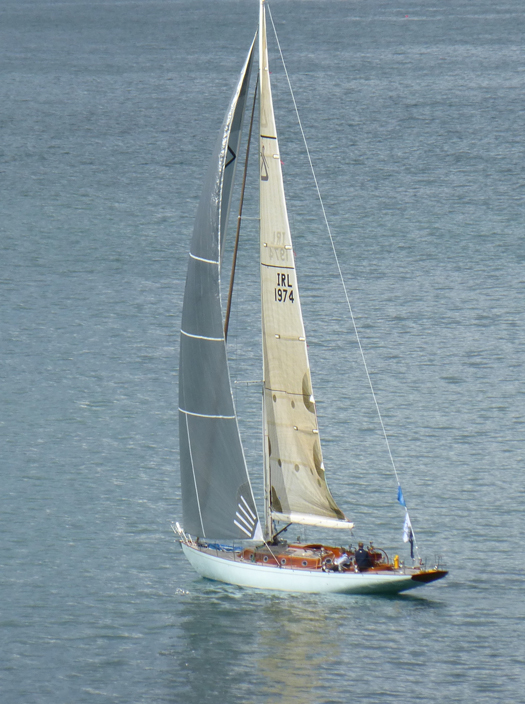 Soufriere approaching the finish of the Aqua Double-Hander at Howth in August, when she would have won overall on both handicaps had she not been becalmed for four minutes within yards of the line. That race-winning headsail may look gossamer light, but on a 54-footer it weighs around 40 kilos, and it's quite a haul for a two man crew to get it aloft. Photo: W M Nixon
Soufriere approaching the finish of the Aqua Double-Hander at Howth in August, when she would have won overall on both handicaps had she not been becalmed for four minutes within yards of the line. That race-winning headsail may look gossamer light, but on a 54-footer it weighs around 40 kilos, and it's quite a haul for a two man crew to get it aloft. Photo: W M Nixon

A penny for your thoughts....David Cagney and Stephen O'Flaherty pondering the options for Soufriere when their just isn't enough wind to get the big lady moving properly. Photo: W M Nixon
Many folk would think it absurd to race a "new classic" like Soufriere against the likes of our opposition last Saturday, as it included Nobby Reilly and Alan Chambers' Mills 36 Crazy Horse, and the Kelly team's J/109 Storm which is always there or thereabouts in ICRA Racing, and has been ICRA Boat of the Year in her time. But Soufriere has a modern underwater profile of vertical bulb keel and spade rudder, and despite her very attractive wood construction in edge-glued strip planking, her all-up weight is only about nine tons.
Nevertheless, she does have to cart about these elegant long ends, which are only an asset for extra speed when the wind is above a certain strength. To add to the challenge, the ideal minimum wind varies, dependent on which point of sailing you're on. Beating, she seems to come to life in as little as 6 knots real wind speed. Reaching, you need about 8 knots. But downwind, she's sticky until it's getting near 10 knots, and preferably more.
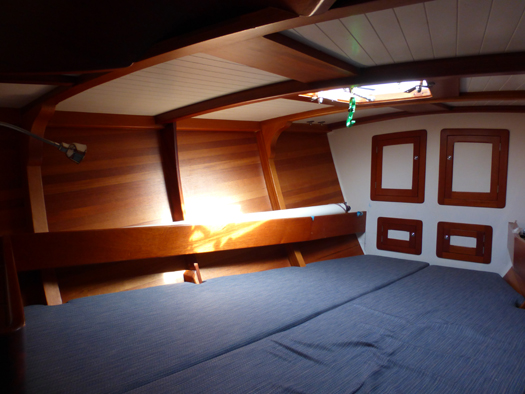
The forward cabin shows the Spirit style. With the wooden hull unlined, the noise of the water going past is pleasantly distinctive. Photo: W M Nixon
As to the impression on going on board, you have to think of Soufriere as they do with the Howth Seventeens, in terms of her waterline length. She certainly doesn't have anything like the accommodation of a standard modern 54 footer, and even her waterline length of 12m (39ft 8ins) suggests more room than there is, as her beam is only 3.3m (10ft 10ins). But within that, the accommodation is welcoming and elegant, and the boat gives out very pleasant vibes, as she is immaculately maintained by Tim Foley of Dun Laoghaire.
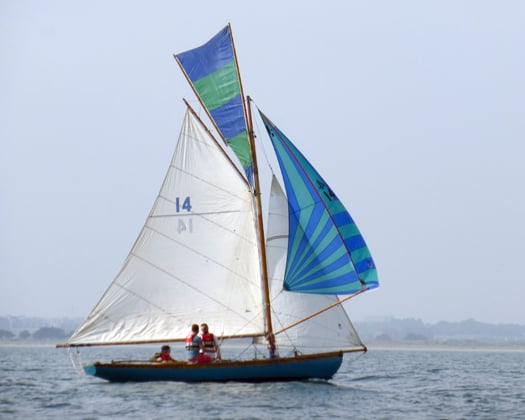
Back in harness. Aidan MacManus of the King Sitric Restaurant has re-joined the Howth 17s by buying the Howth 17 Gladys in partnership with Kieran jameson and others. He first bought Gladys in 1974, and is the first helmsman to have won a race in the Seventeens with 16 other boats astern. Photo: W M Nixon
Going out for the that first race of the re-vitalised Autumn League last Saturday, we motored quietly along past noted restaurateur Aidan MacManus in his Howth 17 Gladys, which he has re-bought in partnership with Kieran Jameson and others. Aidan first bought Gladys in 1974, and he is written permanently into the class's history as in 1988 he was the first skipper ever to win a Howth 17 race with 16 other boats behind, for in a class of such great age, it's seldom that any season will see all the boats afloat.
The wind was light easterly on a day which belied it was mid-September, shirt sleeves stuff and careful reading of summery conditions which were too light for Soufriere. But the team gave it their best shot, and when there was occasionally that essential little bite to the breeze, suddenly we were at the races.
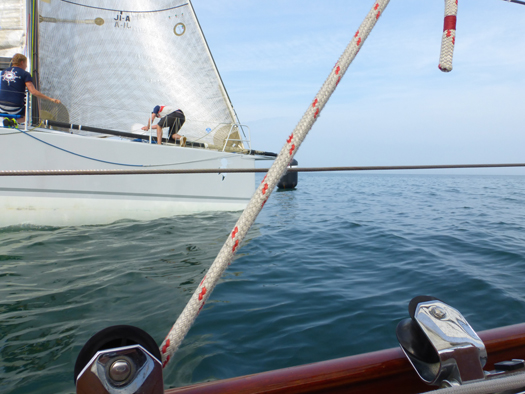
Reaching the weather mark neck-and-neck with Crazy Horse but miraculous to tell.......... Photo: W M Nixon
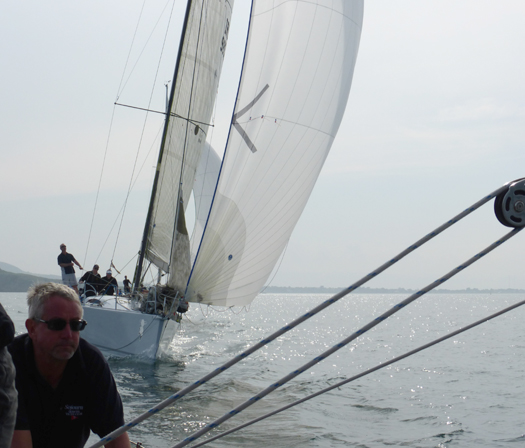
....on the reach Soufriere found her groove and the Horse was soon put astern......Photo: W M Nixon

.....and for as long as we were on the reach, we were lengthening away......Photo: W M Nixon

.....while the crew prepared for the run. Photo: W M Nixon
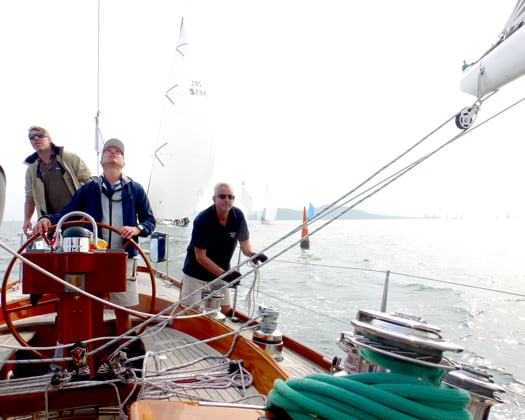
Deflation. We pass the mark at the end of the reach, knowing the run can only mean one thing.......Photo: W M Nixon
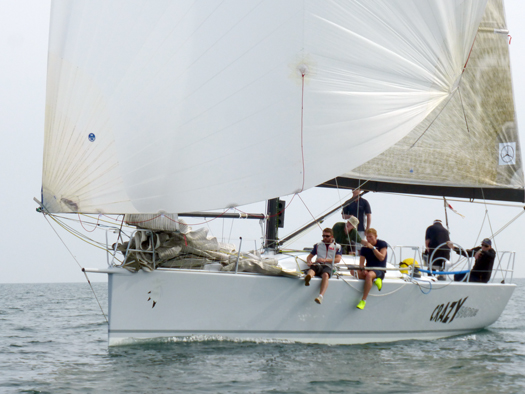
....and with her spinnaker pole deployed, Crazy Horse was soon rolling over us, so we gybed away into what proved to be the light wind side of the leg. Photo: W M Nixon
We rounded the first weather mark vying for the lead on the water with Crazy Horse, and then - mirabile dictu – Soufriere found her mojo and rolled over the Reilly-Chambers boat and led down the short reach to the next turn, but after that it was a wearing dead run with light patches everywhere. Crazy Horse was soon over us again, and as we don't carry a spinnaker pole, we were tacking sharply to lee down the left hand of the run where winds became lighter, while the Horse and Storm went to the right to find a better breeze, and both were ahead at the lee mark.
But then they clearly reckoned they'd used up all the breeze over to the northeast during their success on the run, so for the beat they went to the right where we'd been flat on the run. We meanwhile were left all on our own to do what we wanted, taking a big punt to the left, and it paid in spades. Getting back up to the weather mark, Storm was well astern and we were snapping at Crazy Horse's heels.

On the second long run, we managed to keep in contact with Crazy Horse.....Photo: W M Nixon

.....while Storm took the scenic route, seeking a private breeze in under the cliffs of Ireland's Eye. Photo: W M Nixon
The next run piled on the pain, but somehow we were hanging in with Crazy Horse, and Storm took a flyer right in under the cliffs of Ireland's Eye. With the wind fading, the Committee Boat had gone over towards Malahide to shorten the course at the lee mark, and a fine selection of the 97 boat fleet were running down together towards it from their various courses.
It made for a very civilised finish time instead of hanging around far into the evening, and we might have hoped for a third or even a second as the long lady which is Soufriere had been doing her very best. But then, just as we neared the finish, didn't the breeze pipe up for a crucial quarter of an hour. We finished at a crisp little speed, but down towards Ireland's Eye the two J/109s and the X332 Equinox were coming up towards the finish with bones in their teeth, and a reasonable chance of a third or even a second for us evaporated to fifth, suddenly three minutes down on the fourth-placed J/109 Dear Prudence (Patrick Cruise O'Brien), while the other J/109 Storm had finished at such speed she pipped Crazy Horse for the win.

At last a bite to the breeze, but we're just about to finish.......Photo: W M Nixon
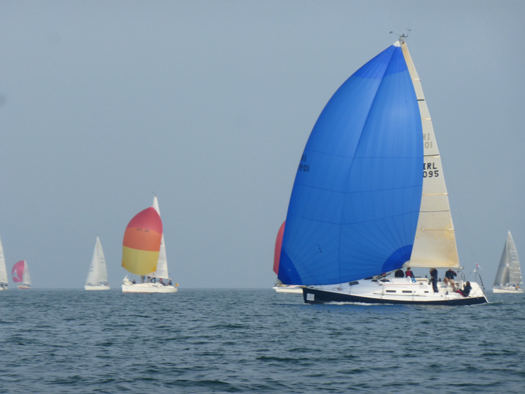
.....so the brief but temporary breeze at the finish brings up the tail-ender Dear Prudence with a bone in her teeth, and Soufriere is pushed back into fifth on CT. Photo: W M Nixon
But that's boat racing. It had been an interesting day in good company, and when she could, the lovely Soufriere rewarded us with competitive performance, at all times with the water tinkling past in that special way it does with a wooden hull. She was a joy to be aboard.
On the 35th Anniversary of the introduction of the Howth Autumn League, it was good to be heading back in the hazy evening sun into this regenerated port where modern facilities are right beside the traditional anchorage. There, the eternally re-born Howth 17s were striking their tops'ls after an afternoon's racing, just as they've always done for 116 years, while continuing with the banter which will go on for ever.
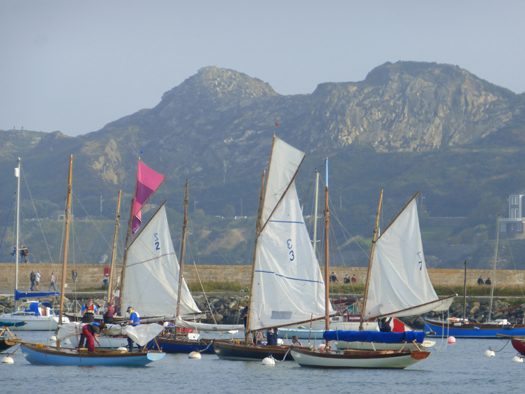
The Howth 17s striking their tops'ls after a Saturday afternoon race, as they have been doing for 116 years. Photo: W M Nixon

A very likeable boat, and remarkably rewarding to race against more modern types. Soufriere in her berth at Howth after the first race of the MSL Autumn League 2014 at Howth, showing the quality of the work Jimmy Foley of Dun Laoghaire puts into her maintenance. Photo: W M Nixon
Join In The Fun At Howth Lifeboat Open Day This Sunday
#RNLI - For a free, fun, family day out, look no further than Howth this Sunday 31 August for the annual Open Day at Howth RNLI.
Between 2pm and 5pm the public can meet the volunteer crew, see the lifeboats and try some of the local food, drink and activities that prove Howth Is Magic.
Last year's event was hailed as a great success and all at the lifeboat station are expecting the same for this year. For more see the Howth Lifeboat Open Day event page on Facebook HERE.
#RNLI - Howth RNLI had a busy start to the weekend, towing two motorboats to safety in separate incidents between Friday night and Saturday morning.
Pagers sounded at 7.15pm on Friday evening (22 August) with a launch request for the inshore lifeboat to locate and assist a motorboat drifting without power in the vicinity of Howth Sound. The motorboat with two people aboard was quickly located and towed to Howth Harbour.
The following morning (Saturday 23 August) pagers alerted again at 11.05am for the inshore lifeboat to locate a motorboat adrift off the nose of Howth. The motorboat with two crewmembers aboard was taken in tow to Howth Harbour.
"On both occasions the crewmembers were able to make radio contact with the shore, supply an accurate description of the vessels and their location which allow us to locate and offer assistance in the quickest possible time," said Howth RNLI helm David Howard.
"We were pleased to see that all crew members on both occasions were wearing lifejackets."
Howth's volunteer crews have one of their busiest seasons yet, with 50 callouts so far.
Howth Lifeboats Respond To Five Callouts In Five Days
#RNLI - Sunday's aid of a fishing trawler with a fouled propeller near Lambay Island was just one of five callouts or the volunteers at Howth RNLI within five days, marking one of the busiest seasons for the North Co Dublin crew.
These callouts were mainly to vessels that had developed problems while at sea and the lifeboats were called to assist and tow them to safety.
The first was on Saturday 9 August, when Howth’s inshore lifeboat was launched at 10.30am to locate and assist a motorboat that had started to take on water and was trying to make its way back to Howth Marina. The lifeboat crew escorted the vessel safely back to the harbour.
On Sunday evening, following the all-weather lifeboat's fishing trawler rescue previously reported on Afloat.ie, the inshore lifeboat was launched as darkness fell to assist a vessel which had run out of fuel outside Howth Harbour.
The motorboat, with three people aboard, was located and towed back to the public slipway where the motorboat had departed from earlier that day.
More recently, yesterday (Wednesday 13 August) the all-weather lifeboat launched at 1.40pm to tow a sailing vessel with steering problems back to the harbour.
The 43-foot sailing yacht, with three people aboard, was taken in tow and brought to Howth Marina.
Later in the evening, the all-weather lifeboat was again launched to assist a motorboat with engine problems to the north west of Ireland’s Eye. The vessel was quickly located and towed back to Howth Harbour.
“It has been a particularly busy time in Howth for both our lifeboats," said Howth RNLI volunteer lifeboat crew member David Howard, "but we are pleased that all our recent callouts resulted in no injury and all casualty vessels were safely towed back to Howth Harbour.
"All the vessels had means of contacting the shore and we compliment the skippers of the boats in not hesitating to call for help at the first sign of difficulties.”
Howth Lifeboat Tows Fishing Trawler To Safety
#RNLI - Howth RNLI's all-weather lifeboat launched at 1.20pm yesterday afternoon (10 August) to reports of a fishing trawler with a fouled propeller drifting north-east of Lambay Island.
Skerries RNLI's volunteer crew also launched their Atlantic 85 lifeboat Louis Simson, but were stood down when it became clear that Howth's Trent-class lifeboat was more apt for the job.
The Howth lifeboat crew located the casualty vessel at 2pm some 12 miles north-east of Howth and established a tow line within 10 minutes of arrival.
The fishing vessel was then safely towed back to Howth Harbour, though progress was slow as a result of deteriorating weather conditions – with a north-west Force 6 wind and a rough sea state – and the return journey took just over two hours.
Howth RNLI coxswain Fred Connolly said after the callout: "We were pleased to locate and assist the fishing trawler so quickly after receiving the call to launch.
"The fishing vessel crew acted very professionally in calling for assistance immediately and they also supplied a accurate position of their location which allowed us to find and assist them so quickly."
Gerry Canning, volunteer lifeboat press officer for Skerries RNLI, added: "The RNLI has a wide range of boats in the fleet to cater for all types of emergencies in all conditions. In this case the Trent all-weather lifeboat from Howth was definitely the right boat for the rescue."



